- Português do Brasil

Time Travel
- View history
The power to travel through time . Technique of Time Manipulation and Temporal Displacement .
- 1 Also Called
- 2 Fiction-Specific Terms
- 3 Capabilities
- 4 Applications
- 5 Techniques
- 6 Variations
- 7 Associations
- 9 Limitations
- 10.1 Anime/Manga
- 10.2 Video Games
- 10.3 Live Television/Movies
- 10.4 Cartoons/Comics
- 10.5 Literature
- 10.6 Web Original
- 11.1 Cartoons/Comics
- 11.2 Anime/Manga
- 11.3 Live Television/Movies
- 11.4 Literature
- 11.5 Video Games
- 12 Known Locations
- 13.1 Anime/Manga/Manhwa
- 13.2 Comics/Cartoons
- 13.3 Video Games
- 13.4 Live Television/Movies
- 13.5 Web Comics/Original
Also Called [ ]
- Chronoportation/Chronotravel/Chronojumping
- Temporal/Linear-Time Relocation/Travel/Voyage
- Time Jump/Jumping/Leap/Leaping/Traveling
Fiction-Specific Terms [ ]
- Time-Slipping ( Loki )
Capabilities [ ]
Users can travel and send others to the future/past. Some users may be limited to remaining on the same spatial spot of a differing timeline, others may be able to move to a different spatial position.
Applications [ ]
- Alternate Timeline Creation by changing an event while in the past or just traveling/being in the past.
- Alternate Timeline Traveling by traveling between alternate timelines.
- Flash-Forward can travel to the future events.
- Temporal Duplication can create duplicates of themselves by traveling through time and meet with another version of themselves in any moment in time.
- Temporal Rewind can travel to the past events.
Techniques [ ]
- Time Travel Combat
Variations [ ]
- Chronoskimming consciousness time travel
- Dimensional Travel time is considered the fourth dimension
- Precognition
- Temporal Trapping
- Retrocognition
- Space-Time Rift
- Temporal Speed
- Temporal Telepathy
- Temporal Teleportation
- Time Portal Creation
Associations [ ]
- 4th-Dimensional Access
- Advanced Technology
- Alien Physiology
- Alternate Reality Traveling
- Alpha Travel
- Time Traveler from the Future while in the past.
- Dimensional Travel
- Event Experiencing
- Memory Reliving
- Meta Time Travel
- Omega Travel
- Planeswalking
- Planes Dreaming
- Powerful Objects
- Probability Travel
- Quantum Manipulation
- Space-Time Manipulation
- Superior Human Physiology
- Teleportation
- Teleportation Force Manipulation
- Teleportation Manipulation
- Temporal Displacement
- Temporal Interaction
- Temporal Presence
- Temporal Warping
- Time Manipulation
- Basic Level: Users can only travel seconds backwards/forward in time.
- Advanced Level: Users can travel minutes backwards/forward in time.
- Expert Level: Users can travel hours backwards/forward in time.
- Master Level: Users can travel days or several weeks backwards/forward in time.
- Ultimate Level: Users can travel months/to several years backwards/forward in time.
- Absolute Level : Users can travel decades, centuries, or even an eternity backwards/forward in time.
Limitations [ ]
- When traveling to the past, any changes that the user makes may cause a butterfly effect ; for the said user cannot change the way things are without destroying what it was.
- The person's attempt to time traveling may be futile due to the Grandfather Paradox ; preventing them from achieving their goal in altering the past and future, unless they have Ancestral Paradox Defiance .
- May be unable to move to a different location spatially, and instead just end up in the same location in a different timeline. Telefrag is possible as a result.
- Protection conjecture , a cause that prevents the change of the past, could interfere with the Time Travel in some cases. If not and the past is change, results in the present time, before the travel, can have unwanted results.
- Time travel may separate the user from space , which would leave them entrapped within time , rendering them biologically immortal , intentionally or not.
- Abuse and misuse of time travel may result in one's mind losing track in time, causing the body to age but the mind to remain young.
- Because of the complexities and potential dangers, time travel is sometimes considered a taboo and against the law of nature, and even outlawed by some governments.
- Cannot interfere in certain matters concerning the flow of time and space.
- It's not known if the future is protected by the same cause the past is (see Precognition for more info how changes to the future could be prevented).
- May not be able to interact with the past or future (See Precognition or Retrocognition .)
- May distort the space-time continuum in exchange for traveling.
- May only be able to transport living tissue through time.
- May only be able to go either backward or forward in time.
- May only be able to travel the duration of their own lifetime.
- Time travel to the past may create an alternate timeline, in order to prevent changes to affect the original time. This means that the past would branch off into a new dimension of time, while the present timeline would continue as though nothing affected the past. This prevents intended changes.
- Cannot escape users of Temporal Presence .
- Cannot defeat user of Acausality .
- May not be able to travel to events that have been affected by Inevitable Event Creation .
- May have a limit for how long a user can stay in another time.
- May not be able to control the destination, traveling to random times and places.
- Unable to travel back to the state before the universe began.
- Can still be affected by Warp Travel Unravel and Warp Travel Interaction .
- May have to avoid seeing oneself, avoid seeing one's own blood relatives related to the users' own parents, and or closest friends known to the users' parents.
Known Users [ ]
See Also: Time Travel .
Anime/Manga [ ]
- Yū Otosaka ( Charlotte ); obtained through Shunsuke Otosaka
- Shunsuke Otosaka ( Charlotte ); via Time Leap
- Dwellers of the Dangai ( Bleach )
- The Return card ( Card Captor Sakura )
- Kurumi Tokisaki ( Date A Live )
- Abigail ( Denma ); via Intersecting Space
- Ryo Asuka/Satan ( Devilman )
- Timemon ( Digimon Universe: App Monsters )
- Kusuo Saiki ( The Disasterous Life of Saiki K. )
- Doraemon ( Doraemon )
- Nikaido ( Dorohedoro )
- Angels ( Dragon Ball Super ); via "Warp"
- Satoru Fujinuma ( Erased )
- Ultear Milkovich ( Fairy Tail )
- Rebecca Bluegarden ( Edens Zero ); via Cat Leaper
- Rachael/Saintfire Nox ( Edens Zero )
- Kagerō ( Flame of Recca )
- Kurei Mori ( Flame of Recca )
- Ginji Amano ( Getbackers )
- Chiaki Mamiya ( The Girl Who Leapt Through Time )
- Cyberdolls ( Hand Maid May )
- Frederica Bernkastel ( Higurashi: When they Cry )
- Hanyū Furude ( Higurashi: When They Cry )
- Kumosuke ( Hime-chan's Ribbon )
- Yume Furusuna ( Instant Bullet )
- Kagome and InuYasha ( InuYasha )
- Yoshikage Kira ( JoJo's Bizarre Adventure Part IV: Diamond is Unbreakable ); via Another One Bites the Dust
- Time Chojin ( Ultimate Muscle: The Kinnikuman Legacy: Ultimate Chojin Tag Tournament Arc )
- Anima ( Lucifer and the Biscuit Hammer )
- Animus ( Lucifer and the Biscuit Hammer )
- Seiryu ( Magic User Kurohime )
- Aya Asagiri ( Magical Girl Site )
- Mukade ( Naruto )
- Saitama ( One-Punch Man )
- Kozuki Toki ( One Piece )
- Homura Akemi ( Puella Magi Madoka Magica ); only in the first universe.
- Lucius ( Romae Thermae )
- The Academy ( Steel Angel Kurumi )
- Rintaro Okabe ( Steins;Gate ) Via "Time Leap Machine" and D-Mail
- Mikuru Asahina ( The Melancholy of Harhi Suzumiya )
- Youhei Shibusawa ( Talentless Nana )
- Chloe Aubert ( Tensei Shitara Slime Datta Ken )
- Nataru ( Tetsuwan Birdy Decode:02 )
- Ai Ijima ( Time Traveler Ai )
- Mari Hayase ( Time Travel Girl )
- Shinichirou Sano ( Tokyo Revengers )
- Takemichi Hanagaki ( Tokyo Revengers ); via Shake hands with Naoto Tachibana
- Vector Prime ( Transformers Cybertron )
- Shinra Kusakabe ( Fire Force )
Video Games [ ]
- Edna Strickland ( Back To The Future: The Game )
- Saint Germain ( Castlevania: Curse of Darkness )
- Catherine ( Catherine: Full Body )
- Mira ( Dragon Ball Online/Xenoverse )
- Démigra ( Dragon Ball: Xenoverse )
- Doctor When ( Dragonfable )
- Caius Ballad ( Final Fantasy XIII-2 )
- Lightning ( Final Fantasy XIII-2 )
- Noel Kriess ( Final Fantasy XIII-2 )
- Serah Farron ( Final Fantasy XIII-2 )
- Kratos ( God of War )
- The Fates ( God of War 2 )
- Axl Low ( Guilty Gear )
- I-No ( Guilty Gear )
- Cole MacGrath ( Infamous ) as Kessler
- Precursors ( Jak and Daxter )
- Ansem, Seeker of Darkness ( Kingdom Hearts )
- Young Xehanort ( Kingdom Hearts )
- Link ( The Legend of Zelda )
- Max Caulfield ( Life is Strange )
- Pokey Minch ( Mother 3 )
- Natan ( Mobile Legends: Bang Bang )
- Tracer ( Overwatch )
- Arceus ( Pokémon )
- Celebi ( Pokémon )
- Dialga ( Pokémon )
- Zoni ( Ratchet & Clank )
- ClockMan.EXE (Rockman.EXE Operate Shooting Star)
- Portal Masters ( Skylanders )
- Nathaniel Renko ( Singularity )
- Sonic the Hedgehog ( Sonic the Hedgehog )
- Chaos Control move users ( Sonic the Hedgehog )
- Mephiles the Dark ( Sonic the Hedgehog )
- Time Eater ( Sonic the Hedgehog )
- Bowser ( Super Mario )
- Neptune ( Superdimension Neptune VS Sega Hard Girls )
- Lily ( Scribblenauts )
- Turok ( Turok: Dinosaur Hunter )
- Aoko Aozaki ( TYPE-MOON )
- Kischur Zelretch Schweinorg ( TYPE-MOON )
- Time Traveler ( Valkyrie Crusade )
- Frisk ( Undertale )
- Robonyan ( Yo-Kai Watch )
- Robloxians ( ROBLOX ); via Time Watch
- Various WWE Superstars in Road to WrestleMania ( WWE SVR 2011 ) if Christian found parts of the time machine
- KEPO ( Saturn bomberman )
- Crab ( Exploding Kittens )
Live Television/Movies [ ]
- James Cole ( 12 Monkeys )
- Nathael ( Ángel o Demonio )
- Illyria ( Angel )
- Mar Novu/The Monitor ( Arrowverse )
- Time Wraiths ( Arrowverse )
- Eobard Thawne/Reverse-Flash
- Barry Allen/The Flash/
- Nora West-Allen/XS
- Hunter Zolomon/Zoom
- Jay Garrick/The Flash
- Marty McFly ( Back To The Future ) via the DeLorean Time Machine.
- Dr. Emmet “Doc” Brown ( Back To The Future ) via the DeLorean Time Machine and the Time Train.
- Clara Clayton ( Back To The Future Part III ) via the Time Train.
- Jules Brown ( Back To The Future Part III ) via the Time Train.
- Verne Brown ( Back To The Future Part III ) via the Time Train.
- Dr. Tom ( Being Erica ); via Door Projection
- All Doctors ( Being Erica ); via Door Projection
- Cyd Ripley and Shelby Marcus ( Best Friends Whenever )
- Willow Rosenberg ( Buffy the Vampire Slayer )
- Billie Jenkins ( Charmed ); via Projection
- Witches and Warlock ( Charmed ); via Spells
- Cupids ( Charmed ); via their rings
- Malevolent Mame ( The Chase 3: Great Minds Think Alike )
- River Song ( Doctor Who ); via Vortex Manipulator
- Time Agents ( Doctor Who )
- Daleks ( Doctor Who ); via time corridor and emergency temporal shift
- Time Lords ( Doctor Who ); via TARDISes
- Time Lords ( Doctor Who ); via Time Rings
- The Doctor ( Doctor Who ); via TARDIS
- The Master ( Doctor Who ); via TARDIS
- Captain Jack Harkness ( Doctor Who ); via Vortex Manipulator
- The Chosen One ( Every Witch Way )
- King Ghidorah/Mecha-King Ghidorah ( Godzilla vs King Ghidorah )
- Arthur Petrelli ( Heroes )
- Hiro Nakamura ( Heroes )
- Peter Petrelli ( Heroes )
- Gokaigers ( Kaizoku Sentai Gokaiger )
- Leo ( Los Protegidos )
- Kamen Rider Den-O ( Kamen Rider Den-O )
- Kamen Rider Kabuto ( Kamen Rider Kabuto )
- Kamen Rider Wizard ( Kamen Rider Wizard )
- DJ Sagara ( Kamen Rider Gaim )
- Kamen Rider Zi-O ( Kamen Rider Zi-O )
- Kadoya Tsukasa ( Kamen Rider Zi-O ); via Dimensional Wall
- Time Jackers ( Kamen Rider Zi-O )
- Sundial World ( Kikai Sentai Zenkaiger )
- Lucy ( Lucy )
- Agent J ( Men in Black )
- Timerangers ( Mirai Sentai Timeranger )
- Curtis Donovan ( Misfits )
- Simon Bellamy ( Misfits )
- Emma Swan ( Once Upon a Time )
- Zelena ( Once Upon a Time )
- The Tall Man ( Phantasm )
- Samuel Beckett ( Quantum Leap )
- Captain Braxton ( Star Trek )
- Crewman Daniels ( Star Trek )
- Q ( Star Trek )
- Vosk ( Star Trek )
- Captain Kathryn Janeway ( Star Trek )
- Poli Truper ( Supertorpe )
- Angels ( Supernatural )
- Castiel ( Supernatural )
- Chronos ( Supernatural )
- The Boy/Number Five ( The Umbrella Academy )
- Merlin ( The Sword in the Stone )
- Terminators ( The Terminator Franchise )
- Tom Turbo ( Tom Turbo )
- Nanno ( Girl From Nowhere )
Cartoons/Comics [ ]
- Gwen Tennyson ( Ben 10 ); via magic
- Gumball Watterson ( The Amazing World of Gumball ); via "Clockdown"
- Darwin Watterson ( The Amazing World of Gumball ); via "Clockdown"
- Chaos Knuckles ( Archie's Sonic the Hedgehog )
- Silver Agent ( Astro City )
- Eon ( Ben 10 )
- Professor Paradox ( Ben 10: Alien Force/Ben 10: Ultimate Alien/Ben 10: Omniverse )
- Time Beasts ( Ben 10: Omniverse )
- Bunsen (Bunsen is a Beast)
- Clockwork ( Danny Phantom )
- Booster Gold ( DC Comics )
- Chronos ( DC Comics )
- Phantom Stranger ( DC Comics )
- Rip Hunter ( DC Comics )
- Kal-El/Clark Kent/Superboy-Prime (Earth 33) ( DC Comics )
- Kal-El/Clark Kent/Superman ( DC Comics )
- Max Mercury
- Wally West/The Flash III
- Barry Allen/The Flash II
- Zatanna Zatara ( DC Comics )
- John Constantine ( DC Comics )
- Mister E ( DC Comics )
- Monarch ( DC Comics )
- Batman, God of Knowledge ( DC Comics ); via the Mobius Chair
- Edd ( Eddsworld )
- Time Swap Sammy ("Final Space")
- Go Go Moba Boy ( Go! Go! Moba Boy! )
- "Enigma" ( Girl Genius )
- Dave Strider ( Homestuck )
- Lord English ( Homestuck )
- Jester ( Imbattable )
- Mister Invincible ( Imbattable )
- Ms. Valerie Frizzle ( The Magic School Bus ); via Magic Bus
- Acronix ( Lego Ninjago: Masters of Spinjitzu )
- Krux ( Lego Ninjago: Masters of Spinjitzu )
- Rex Dangervest ( The Lego Movie 2 The Second Part )
- Eva Bell/Tempus ( Marvel Comics )
- Lucas Bishop ( Marvel Comics )
- Deathlok Prime ( Marvel Comics )
- Doctor Victor Von Doom ( Marvel Comics ); via Time Platform
- God of Stories Loki ( Marvel Comics )
- Iron Man 2020 ( Marvel Comics )
- Kang the Conqueror ( Marvel Comics )
- William Kaplan/Wiccan ( Marvel Comics )
- Morgan Le Fay ( Marvel Comics )
- Wanda Maximoff/Scarlet Witch ( Marvel Comics )
- The One-Above-All ( Marvel Comics )
- Magik/Illyana Rasputina ( Marvel Comics )
- Franklin Richards ( Marvel Comics )
- Nathaniel Richards/Iron Lad ( Marvel Comics ); via Iron Lad Armor
- Dr. Stephen Strange ( Marvel Comics )
- Nathan Summers/Cable ( Marvel Comics )
- Adam Warlock ( Marvel Comics )
- Thor Odinson ( Marvel Comics )
- The Vision ( Marvel Comics )
- Alix Kubdel/Bunnyx/Timebreaker ( Miraculous: Tales of Ladybug & Cat Noir )
- Timetagger ( Miraculous: Tales of Ladybug & Cat Noir )
- Gabriel Agreste/Monarch ( Miraculous: Tales of Ladybug & Cat Noir )
- Mot ( Mot )
- Discord ( My Little Pony: Friendship is Magic )
- Twilight Sparkle ( My Little Pony: Friendship is Magic )
- Starlight Glimmer ( My Little Pony: Friendship is Magic )
- Hue Troop ( OK K.O.! Let's Be Heroes )
- Miles Woodman
- Randy Smith
- Maria Ramirez
- Kyle Langon
- Shleemypants ( Rick and Morty )
- Sabrina Spellman ( Sabrina the Teenage Witch )
- Aku ( Samurai Jack )
- Chroneks ( Sendokai Champions )
- Walker Sloan ( Spider-Man: Edge of Time )
- Nina Crocker/Timezone ( Static Shock )
- Ezra Bridger ( Star Wars ) via World Between Worlds
- T-Infinity ( Terminator 2: Infinity )
- Time Squad ( Time Squad )
- Renet ( Teenage Mutant Ninja Turtles ); via Time Scepter
- Uncle Grandpa ( Uncle Grandpa )
- Number Five/The Boy ( The Umbrella Academy/Dark Horses Comics )
- Marco William Lake ( The Warrior of the Quest )
Literature [ ]
- Catty Turner ( Daughters of the Moon )
- The Citizen ( Good Enough Evil )
- Time Leap Machine ( Steins;Gate )
- The Time Traveler ( The Time Machine )
- Henry DeTamble ( Time Traveler's Wife )
- Some of those who participate in the Witness Anonymous Relocation Program ( W.A.R.P. Series )
Web Original [ ]
- Nuum ( Captus Cinematic Universe )
- The Smiling Man ( Creepypasta ); implied
- Karl Jacobs ( DreamSMP )
- HABIT ( EverymanHYBRID )
- The Blacksmith ( RWBY ); implied
- Mary Nakayama ( SCP Foundation )
- Alexandria ( SCP Foundation )
- SCP-239 - The Witch Child ( SCP Foundation ); not physically
- SCP-2003 - Preferred Option ( SCP Foundation )
Known Objects [ ]
See Also: Time Machine .
- Uchrono Hourglass ( American Dragon: Jake Long )
- Buzz's Time Watch ( Buzz Lightyear of Star Command )
- Time Vehicles ( Milo Murphy's Law )
- Time Travelinator
- Professor Time's Time Machine
- The Time Booth ( The Adventures of Jimmy Neutron: Boy Genius )
- Berby ( Xavier Riddle and the Secret Museum )
- Chrona-Arch ( The Adventures of Jimmy Neutron: Boy Genius )
- Déja-Vu Stone ( Jackie Chan Adventures )
- Time-Traveling Crystal Ball ( Jackie Chan Adventures )
- Temporal Boomerang ( Ben 10 Comic )
- Time Cycles ( Ben 10: Omniverse )
- Chronoscaphe ( Blake and Mortimer - The Time Trap )
- Time Machine ( Calvin and Hobbes )
- Cosmic Treadmill ( DC Comics )
- Cosmic Motorcycle ( DC Comics )
- The Mobius Chair ( DC Comics )
- The Time Bubble ( DC Comics )
- Time Sphere ( DC Comics )
- Green Lantern Ring ( DC Comics )
- Time Medallion ( Danny Phantom )
- Time Sphere ( Futurama )
- Professor Farnsworth's Forward Time Machine ( Futurama )
- The Phoenix Gate ( Gargoyles )
- Time Tape ( Gravity Falls )
- Time Monkey ( Kim Possible: A Stitch in Time )
- Iron Doom ( LEGO Ninjago: Masters of Spinjitzu )
- Time Gem ( Marvel Comics )
- Doctor Doom's Time Platform ( Marvel Comics )
- Kang's Time Chair ( Marvel Comics )
- Timestream Armor ( Marvel Comics )
- Time Diamonds ( Marvel Comics )
- The WABAC ( Mr. Peabody & Sherman )
- Star Swirl the Bearded's time spell scroll ( My Little Pony: Friendship is Magic )
- Martin Luther King Jr's wristwatch/watch ( Our Friend, Martin)
- Time McChine ( Randy Cunningham: 9th Grade Ninja )
- Mach 6 ( Speed Racer: The Next Generation )
- The Hourglass ( Steven Universe )
- Time Scepter ( Teenage Mutant Ninja Turtles )
- Fully charged Eliacube ("Wakfu")
- Stone of Memories ( Winx Club )
- Sands of Time ( Xiaolin Showdown )
- Time Machine ( Meet the Robinsons )
- Duggee's Time Machine ( Hey Duggee )
- Time Headwear ( Pinkfong and Baby Shark )
- Time Machine SB-129 ( SpongeBob SquarePants )
- Intersecting Space ( Denma )
- Backlander ( Dinosaur King )
- Time Slipper ( Dr. Slump )
- Time Rings ( Dragon Ball Super )
- Edens Zero ( Edens Zero ); via large Etherion Crystal endowed with Rebecca's power.
- Bone-Eater's Well ( InuYasha )
- Karasuki ( Boruto: Naruto Next Generations )
- Toki Toki no Mi/Time-Time Fruit ( One Piece )
- Volkswagen New Beetle ( Austin Powers )
- Time Stone ( Arrowverse )
- Chronosphere ( Alice Through the Looking Glass )
- Tempus Infinituum spell ( American Horror Story: Coven )
- DeLorean Time Machine ( Back To The Future )
- Jules Verne Time Train ( Back To The Future Part III )
- The Phone Booth ( Bill & Ted's Excellent Adventure )
- The Crystals/sing sing stone ( Dinosaur Island 2014 )
- Dalek Time Machine ( Doctor Who )
- TARDIS ( Doctor Who )
- Vortex Manipulator ( Doctor Who )
- Time Jerker's Time Machine ( Henry Danger )
- Hot tub time machine ( Hot Tub Time Machine )
- DenLiner and other Time Trains ( Kamen Rider Den-O )
- Waverider ( Legends of Tomorrow )
- The Box ( Primer )
- Nell Rickards' radio ( Round the Twist )
- Armageddon Device ( Spy Kids: All the Time in the World )
- Timeships ( Star Trek )
- Guardian of Forever ( Star Trek )
- Time Jumpers ( Stargate )
- Stargates ( Stargate ); if a wormhole crosses through a solar flare.
- Blobbin's Time Machine ( The Thundermans )
- Time Displacement Equipment ( The Terminator )
- The Map ( Time Bandits )
- Time-Traveling Briefcase ( The Umbrella Academy )
- Omri’s Cupboard ( The Indian in the Cupboard )
- Time Di’Alla ( Agents of Shield)
- Purple Potty ( Captain Underpant book series )
- Gigantic, Glow-In-The-Dark, Robo-Squid ( Captain Underpant book series )
- Tinkle-Time Travelometer ( Captain Underpant book series )
- Time Cosmos ( Dooly the Little Dinosaur )
- Time-Turner ( Harry Potter )
- The Atlas ( The Books of the Beginning )
- W.A.R.P. Pod ( W.A.R.P. series )
- MTD ( Call of Duty: Black Ops )
- The Epoch/The Wings of Time ( Chrono Trigger )
- Phase Distorter ( EarthBound )
- Mirror of the Fates ( God of War 2 )
- Harp of Ages ( The Legend of Zelda: Oracle of Ages )
- Ocarina of Time ( The Legend of Zelda: Ocarina of Time/Majora's Mask )
- Chrono-Accelerator ( Overwatch )
- Time Machine ( Sly Cooper: Thieves in Time )
- Chaos Emeralds ( Sonic the Hedgehog )
- Time Stones ( Sonic the Hedgehog )
- Lily’s Globe ( Scribblenauts )
- Phone Booth ( WWE SVR 2011 )
- Aiai's Time Clock ( Super Monkey Ball Banana Splitz )
- Meemee's Time Shoulder Bag ( Super Monkey Ball Banana Splitz )
- Baby's Time Diaper ( Super Monkey Ball Banana Splitz )
- Gongon's Time Belt ( Super Monkey Ball Banana Splitz )
- Amelia Watson's Watch ("Hololive")
- Turntables ( Homestuck )
- Music Box ( Homestuck )
- SCP-001 - "A Record" (Kate McTiriss's Proposal) ( SCP Foundation )
- SCP-1780 - The Temporal Anomalies Department ( SCP Foundation )
- SCP-052 ( SCP Foundation )
Known Locations [ ]
- Dranakis Threshold ( Chaotic )
- Helipad ( God of Gamblers III: Back to Shanghai )
- The Bone-Eater's Well ( Inuyasha )
- Quantum Realm ( Marvel Cinematic Universe )
- Time Hole ( Mario & Luigi: Partners in Time )
- World Between Worlds ( Star Wars )
- The Magic Tree House ( The Magic Tree House )
- Forbidden Fall ( The Smurfs film ); when the moon is blue
Gallery [ ]
Anime/manga/manhwa [ ].

Comics/Cartoons [ ]
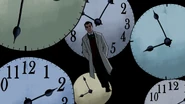
Web Comics/Original [ ]

- 1 Superpowers
- 2 List of Kinetic Abilities
- Superpowers We Wish We Had
- History's Greatest Superheroes
- The Greatest Comic Book Villains
- Best Non-DC or Marvel Movies
- The Best Teenage Superheroes
- Villains with Sad Origin Stories
- Superheroes Who Have Gone Bad
- The Most Absurd Superheroes
- Most Powerful Superhero Families
- When Villains Actually Won
- Most Powerful Non-DC or Marvel Characters
- Superheroes Who Are Mass Murderers
- But Who Is the Smartest?
- 16 Great Superhero Duos, Ranked
- Superheroes Inspired by Real People
The Strongest Time-Traveling Superheroes, Ranked
The realm of time-traveling superheroes presents a captivating fusion of power and potential. These heroes can travel through history with incredible ease, altering timelines to prevent catastrophes, A diverse group of characters like Flash, Doctor Strange, and Cable showcase their talents in this riveting subject matter.
The domain of time travel characters includes many opportunities for excitement and suspense. Their exceptional skills that set them apart from other superheroes stem from their ability to master one of the most enigmatic aspects of existence - time itself. These awe-inspiring individuals harness their powers to navigate past, present, and future, accomplishing exploits that defy conventional norms. Hold on tight as you embark on a rollercoaster ride through space and time with these personalities.
Flash's astonishing speed enables him to breach temporal boundaries at will; Doctor Strange employs his mystical arts prowess to manipulate reality and traverse dimensions; while Cable boasts telepathic abilities and an advanced understanding of futuristic tech. These beings utilize their strengths for good deeds while safeguarding humanity. These heroes represent just a fragment of what makes this specific genre alluring.
The stories of these characters show how far comics have come in terms of creativity and depth. It's apparent that fans will never lose their appetite for narratives pushing boundaries and expanding imaginations.

- # 2 of 189 on The 100+ Best DC Comics Heroes Of All Time, According To Fans
- # 7 of 14 on 14 Times Superheroes Passed The Torch And Comic Book Fans Said No Thank You
- # 8 of 285 on The Best Comic Book Superheroes Of All Time, Ranked By Fans

Doctor Strange

- # 115 of 843 on The Greatest TV Characters Of All Time
- # 17 of 61 on The Greatest Scientist TV Characters
- # 50 of 159 on The Most Likeable TV Anti-Heroes

- # 17 of 64 on The Best X-Men Characters Of All Time
- # 45 of 285 on The Best Comic Book Superheroes Of All Time, Ranked By Fans
- # 33 of 218 on The Top 100+ Marvel Comics Superheroes

Green Lantern
- # 17 of 285 on The Best Comic Book Superheroes Of All Time, Ranked By Fans
- # 4 of 82 on The Best Members Of The Justice League, Ranked By Fans
- # 4 of 12 on 12 Superheroes Whose Best Friend Turned Into Their Archnemesis

Doctor Manhattan
- # 63 of 189 on The 100+ Best DC Comics Heroes Of All Time, According To Fans
- # 93 of 285 on The Best Comic Book Superheroes Of All Time, Ranked By Fans
- # 1 of 14 on 14 DC Villains Who Could Test The Limits Of Wolverine's Healing Ability

Spider-Man 2099
- Dig Deeper... Who Is Spider-Man 2099, The Mysterious New Character From 'Across the Spider-verse'?
- # 61 of 218 on The Top 100+ Marvel Comics Superheroes
- # 5 of 20 on The Greatest Spider-Man Costumes of All Time

Franklin Richards
- # 67 of 102 on The Best Teenage Superheroes
- # 8 of 73 on The Most Powerful Comic Book Characters Ever, Ranked
- # 8 of 12 on 12 Major Marvel Characters Who Have Wild Super-Kids In The Distant Future

Booster Gold
- # 68 of 189 on The 100+ Best DC Comics Heroes Of All Time, According To Fans
- # 185 of 285 on The Best Comic Book Superheroes Of All Time, Ranked By Fans
- # 34 of 82 on The Best Members Of The Justice League, Ranked By Fans

- # 225 of 305 on The Best Comic Book Villains
- # 25 of 64 on The Best X-Men Characters Of All Time
- # 136 of 285 on The Best Comic Book Superheroes Of All Time, Ranked By Fans

Iris West Allen

- Entertainment
- Superheroes
- Ranker Comics
- Watchworthy
- Comic Book Characters
- Fictional Characters
Ranking comic book characters by their powers, strength, physical traits, affiliations, and other features, like how just goshdarn super they are.
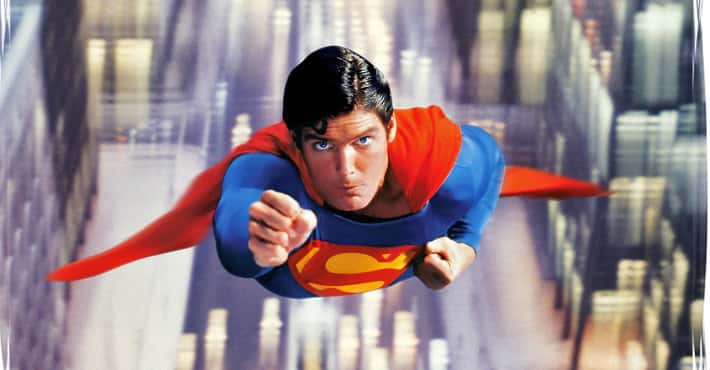
Top 10 Most Powerful Superheroes Who Can Travel Through Time

Your changes have been saved
Email Is sent
Please verify your email address.
You’ve reached your account maximum for followed topics.
10 Marvel Heroes Who Became Villains And Stayed That Way
When batman and superman first acknowledged the justice league in their own comics, marvel's latest x-men trend may be doing more harm than good.
Traveling through time is the ultimate ace in the hole when it comes down to superhero battles and plenty of DC and Marvel super-powered beings, including some anti-heroes, are gifted with this powerful ability.
RELATED: Shocking! The 10 Best Electrically Powered Heroes
In some cases, these heroes' time-manipulating skills are the side effects of talents that, in and of themselves, have nothing to do with journeying to the past or the future, like super-speed for example. Any damage taken or mistakes that were made are irrelevant in the presence of these ten powerful superheroes who can defeat their enemies and right their wrongs by going forward and backward through time.
The fastest man in the DC universe, Barry Allen — The Flash is so quick that he is capable of traveling through time. That gives him the power to alter timelines just like in the Flashpoint story in order to restore the world to its normal state. Furthermore, he can even go beyond that and travel across what is known as hypertime — the stream of multiple timelines, which allows visitors to hop from one reality on to another.
9 Doctor Strange
The Doctor doesn't really need the Time Stone as shown in the MCU in order to time travel. The Master of the Mystic Arts is capable of manipulating time without it, in a variety of ways through his formidable magical capabilities . Strange is able to stop time, slow it down or he can just travel to the past or the future. Despite his remarkable skills, he still requires a significant amount of concentration in order to pull this particular trick off.
Young Superman , back in the Silver Age of comics, was able to travel through time. His later, more grounded version, was deprived of that skill probably so that his opponents can be more of a threat to him.
RELATED: 15 Children Of DC Superheroes Who've Become More Powerful Than Their Parents
The less experienced Clark Kent, however, known as Superboy during the Pre-Crisis period was just a casual time-traveler who could simply move faster than light, affect his past and future self and occasionally, take people with him for the ride.
Rina Patel discovered her one and only power by accident, which started her on an adventure that led the unsuspecting college student to the New Warriors. Timeslip can travel to the future or the past and manipulate time in basically every other way. If Patel wants to be faster than a foe, she slows time down. If she wants to fast-forward to a moment in the future, Rina simply speeds it up. This ability also allows her to be super fast (in the eyes of others).
Nathan Summers can manipulate timelines through his psionic powers. Cable is able to transport himself as well as other individuals to any point in time and he can stay there temporarily (from a few minutes to years).
RELATED: Marvel Comics: 10 Most Powerful Superheroes Who Control Weather
Summers is also capable of going through this special type of travel in his astral form (his spirit detached from his body). Although Nathan used the ability once and it was extremely difficult, there is no certain proof that he is incapable of doing it again.
Nathaniel Richards (Iron Lad) from Marvel's Other Earth (Earth - 6311) brought peace to this particular version of the planet and its history after arriving through time-travel. His armor is quite similar to Tony Stark's and shares many of his Iron Man suit's features . The one difference is that Iron Lad's armor allows him to create temporal divergences, which let him manipulate time and travel through it. Richards also has a ship featuring that same ability.
DC's Godspeed can travel through time with the assistance of Barry Allen's Cosmic Treadmill. The device allows August Heart to jump into the timestream and move to whatever point in the past or the future he prefers. All of that is possible because of his Speed Force connection that grants him a number of other superhuman abilities such as enhanced stamina, strength, reflexes, healing and dimensional travel.
Bishop is a mutant of considerable talents and he is a master of energy absorption but one other very special ability of his is time travel. The member of the X-men is a capable time-traveler because of the Forge cybernetic arm that Bishop claimed as a replacement of his lost limb.
RELATED: Marvel Comics: 10 Most Powerful Marvel Superheroes Who Control Fire
The prosthetic is equipped with a technology, which allows Lucas to time-jump and move so quickly that he appears to be super-fast to the individuals that surround him.
2 Booster Gold
This particular DC superhero doesn't have any special powers of his own - his strength is derived from the artifacts that he stole from a future museum. Gold's power suit makes him quite a formidable being. One of its many uses is the so-called Time-travel circuitry or Chronokinesis, which is more or less the upgraded version of time travel since it also allows the user to manipulate the timestream from a distance.
1 Green Lantern
The Green Lantern Power Ring grants the wearer with many abilities but one of the most powerful and yet, somehow less popular ones is time travel. Naturally, more willpower is required for farther trips into the future. Hal Jordan, in particular, has definitely proved his mental toughness and spiritual resilience since he has successfully explored as far as the 70th century. Also, the Power Ring allows the Lantern to communicate with other individuals that are from a different point in time.
NEXT: DC: 10 Superheroes Who Were Given Their Powers
- marvel comics
10 Best time-travelling superheroes of all time
Get confused in time with these best time-travelling superheroes ever
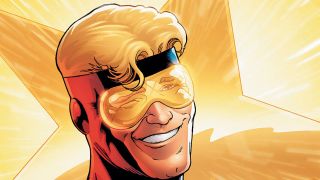
Time travel is having something of a moment in current superhero media, and that's not just because Avengers: Endgame used time travel as a key plot device. But none of that would be possible without the help of the best time-travelling superheroes of all time.
So what better time than now to look at the best time-travelling superheroes ever?
10. Waverider

The almost-forgotten hero from the alternate timeline of DC Comics ' 1991 event Armageddon 2001, Matthew Ryder escaped a dystopian dictator and certain death by traveling into the past with the ability to "read" potential futures of people just by touching them.
Unfortunately, while he prevented his future from happening, he did so by accidentally causing the creation of his dictator nemesis a decade early, setting in motion events that led to the Zero Hour crossover years later.
In recent years, Waverider has returned in spirit as the namesake of Rip Hunter's time ship in DC's Legends of Tomorrow - a unique live-action transition, to say the least.
9. Iron Lad

The Young Avengers' first leader sought to balance the scales for things that he'd do later in life - time travel can get weird, when it comes to cause and effect, remember - by adopting the guise of Iron Lad before he grew up to become the villainous Kang the Conqueror.
As Iron Lad, he managed to lead the team's short-lived first incarnation before fate - or the time-traveling equivalent - asserted itself, taking him to his destiny as one of the Avengers' most famous, and most deadly, foes. His career may not have been the longest, but his aim was true…
Comic deals, prizes and latest news
Get the best comic news, insights, opinions, analysis and more!
8. Deathlok

The original Deathlok was Luther Manning, a man from the post-apocalyptic future world of 1990 - well, he was created in 1974 — who traveled back to the present to find himself teaming up with the Thing and Nick Fury (after earlier clashes, of course) to try and undo the world from which he came.
Since most of us will recall that 1990 was not the year society collapsed into dystopian ruin, we'll have to assume he succeeded.
Good job Deathlok!
7. Guardians of the Galaxy

No, not the current team, but the original 1969 lineup which decided to try and save the world of the 31st century by travelling back to our time and recruiting some more heroes to the cause.
Along the way, they had numerous chances to accidentally screw up things, but always managed to avoid it - even when that meant avoiding spilling the beans to Vance Astrovik, the future New Warrior known as Justice, that one of their members was… Well, an alternate version of himself. All that and they defeated the Badoon invasion that was the reason behind their formation.
Members of this version of the team even appeared in Guardians of the Galaxy Vol. 2, with writer/director James Gunn pointing to the potential of future film stories featuring the characters.

One of the two most time-travel-y X-Men, Lucas Bishop didn't really intend to be a time traveler; instead, it was more a matter of doing his job as one of the XSE (Xavier's Security Enforcers) and following a bad guy through a time portal.
Like Rachel Summers, he watched as the future he'd arrived from became more and more likely, but unlike Rachel, he decided to do something about it… Namely, try and kill Hope, even if that meant traveling through time again and hunting down Cable to make sure it happened (actions that got him on our time-traveling villains list, as well). He failed, of course, and realigned himself with the X-Men once again.
5. Green Lantern

What's that? You don't tend to think of Green Lantern as a time-traveler? Clearly, you've never heard of Pol Manning, Earth's Greatest Hero in the year 5700 — better known, perhaps, as Hal Jordan. The surreal existence of Manning is one of the stranger pieces of Green Lantern lore: When in need of a hero to save the world, the governments of the Earth of 5700 would simply kidnap Jordan from his own time, wipe his memory and give him the temporary (fictional) identity of Manning before returning him to his rightful time, place and mindset.
Sure, Jordan may not have been in control of - or even fully aware of - his time traveling double life, but that doesn't mean that he didn't serve as a Time Cop as well as a Space Cop when the situation demanded it.
4. The Flash

With the creation of the wonderfully-named Cosmic Treadmill, The Flash mythos gained a whole new dimension as the speedy superhero was suddenly given the ability to travel through time, meaning that his adventures could take place any when as well as any where.
Of course, it was only a matter of time before this ability would end up being exploited in the wrong way, leading to a butterfly effect mix up that created Flashpoint and the New 52, but for that brief period before everything went wrong, the Flash could be relied upon to clean up messes all through time.
Time travel has even played a significant role as a plot element in CW's The Flash too.
3. Superboy

For a teen who'd grow up to become the world's greatest superhero, it's almost disappointing to discover that it took three time-traveling teens from the 30th (later, 31st) century to introduce Clark Kent to the mysteries of the timestream.
Once the Legion of Super-Heroes entered his life, Superboy became a regular passenger on the cross-time express, either by Time Bubble or under his own steam but somehow always managing to stay away from any knowledge of his future self's actions, which may end up being his most impressive feat, considering just what Superman ended up accomplishing during his long career.
Now, the current Superboy, Jon Kent, looks to be the latest inheritor of the mantle to adventure alongside the Legion of Super-Heroes.

To try and get into the reasoning behind Cable and his various time-travel escapades would be both exhausting and confusing, so let's just leave it at this: At no point during his entire decades-long career as the X-Men family's favorite techno-organic enforcer has he managed to entirely undo the time stream by needlessly slaughtering another superhero, even with the amount of heavy artillery he carries around at all times.
Cable was played by Josh Brolin in Deadpool 2, a movie that hinged on his time-traveling nature (and provided the fuel for an all-time-classic mid-credits stinger scene).
1. Booster Gold

Perhaps comic books' top time-traveling superhero, Booster Gold may have started off his superheroic career with one simple time jump, but since then, he's teamed with Rip Hunter - who may or may not have been Booster's son - to protect the timestream from unwanted changes, only to fall victim to the rewriting of all DCU history via the New 52, where he's traveled into the past to meet Jonah Hex, and later went back to the future as part of Justice League 3001.
Booster recently returned to the DC Universe as part of Heroes In Crisis - another story in which time travel played a role. He'll next appear in the era-spanning Legion of Super-Heroes: Millennium this September.
It might be dangerous, but is time travel one of the most useful super powers ?
I've been Newsarama's resident Marvel Comics expert and general comic book historian since 2011. I've also been the on-site reporter at most major comic conventions such as Comic-Con International: San Diego, New York Comic Con, and C2E2. Outside of comic journalism, I am the artist of many weird pictures, and the guitarist of many heavy riffs. (They/Them)
Concord and Astro Bot look great, but are a symptom of the weird year PlayStation and the PS5 is having
Everything announced at the PlayStation State of Play May 2024
My favorite thing about Breath of the Wild is all the mini-open-worlds it inspired, and another one just hit Steam with near-perfect reviews
Most Popular
- 2 Senua's Saga: Hellblade 2 review: "Nothing short of video game sorcery"
- 3 Lorelei and the Laser Eyes review: "Totally engrossing, effortlessly stylish, and one of the best puzzle games of 2024"
- 4 Dune: Imperium - Uprising review - "An elegant mix"
- 5 Homeworld 3 review: "Brings the series safely into the modern era"
- 2 Sasquatch Sunset review: "An eccentric concept makes for the best Bigfoot film yet"
- 3 The Beast review: "An elegant but ultimately unwieldy sci-fi drama”
- 4 Sting review: "Alien’s influence resonates in this playful creature feature"
- 5 Atlas review: "Netflix's new sci-fi needs more flesh on its AI-themed bones"
- 2 Doctor Who season 1, episode 5 review: "'Dot and Bubble' is like a family-friendly Black Mirror"
- 3 Doctor Who season 1, episode 4 review: "A horror tour de force that will stay with you for years to come"
- 4 X-Men ’97 episode 10 review: "A near-perfect ending to an exciting and tumultuous season"
- 5 Doctor Who season 1 episode 3 review: "Steven Moffat’s return with 'Boom' is an instant classic"
- Skip to main content
- Skip to primary sidebar
- Skip to footer
Author Roy Huff
Bestselling science fiction and fantasy author Roy Huff. Amazing books and a sci-fi fantasy super-geek. Join the tribe. Read more.
24 Reasons Time Travel is the Ultimate Superpower
March 5, 2019 by Roy Huff
Hollywood has finally caught on with the Flash, Timeless, Frequency, and DC’s Legends of Tomorrow, but they’re only scratching the surface.
It took confronting a rabid pit bull in middle school to understand the awesomeness of superpowers and how not having them sucks when you’re in a bind.
Imagine staring down a beast foaming at the mouth, not knowing if it would chase you down and infect you with an insidious disease that drives you mad until you succumb to a horrible death. Fortunately, in this case, the only superpower I needed was patience to wait for animal control.
But all superpowers aren’t created equal. With all due respect to Scientologists’ who revere powers like auditing and the ability to hold one’s need to use the restroom, time travel is in a league of its own.
I don’t mean the limited power depicted in most fiction. I’m talking about time travel that avoids the nonsense of the paradox and encompasses slowing time, freezing time, looping time, and moving backward and forward through time at will.
And don’t let some content editor block you with a mysterious force that prevents you from changing too much just because he thinks it’s bad fiction or gives the protagonist too much power. It’s all or nothing, baby. Yes, it’s totally awesome, and you know it. In case you’re not convinced, try these reasons on for size.
Kill Hitler (or Any Other Ruthless Dictator) and See What Happens
Screw the consequences. And don’t tell me Hitler made the world a better place for some sick, twisted reason. Yes, the world would be totally different, but I’d bet it would be a very interesting and good different. Why not find out?
Cream the Kid Who Picked on You in School
If you’ve ever been bullied, you’ll appreciate this one. A few time loops will make you poetic with your jabs and punches, or you could just have a little fun and put them in an awkward position when time resumes at normal speed.
Ace Any Test
If you can’t get an A with the ultimate cheat sheet, it’s time to move on.
Try Out Different Lines on a Prospective Date Until One Works
50 First Dates comes to mind, as does Groundhog Day (my personal favorite). But there’s so much to work with. Who wouldn’t want to know the most beautiful thing to say to that perfect person they’ve always wanted to impress?
Make a Ton of Cash
It’s so obvious, yet so many time travel stories don’t bother to make the most of this storyline. If you controlled time, how would you make a ton of cash? So many possibilities here:
Win the lottery, a hand at poker, or name your gambling vice. Play the stock market. Invest in real estate. Discover hidden loot, buried trinkets, lost relics, and sunken ships. The list is endless.
Invent Gadgets From the Future
Another personal favorite, but I digress. Why not accelerate things a bit? For the environmentally conscious, here’s an excellent way to make alternative energy a cheap efficient reality. Or invent a way to upload information to your brain. While you’re at it, throw in a holodeck and some replicators.
Save Books From the Library of Alexandria (Then Read Them All)
Bibliophiles rejoice! Even lovers of poetry and literary fiction should jump on the sci-fi bandwagon for this one, seriously ! You’ll need to bring a translator, or at least a souped up version of Google Translate. The payoff would be enormous.
Rip Mega Hits From the Future
You may not sound as good, but then again, talent is overrated. It’s not stealing if it hasn’t been invented yet, so ignore the naysayers who complain about the ethics. If it’s fame you desire, this option is a must.
Find out if Your Significant Other is a Cheater
If you have suspicions, they probably are. But if you’ve just started dating, save yourself the headaches and skip ahead.
Buy the Perfect Gift
If you’ve found that perfect love, you know finding the perfect gift can be equally as hard. Those initial facial expressions don’t lie.
See What Happens to Your Kids
For maximum impact, foresight is necessary. Maybe your kid should study art. Find out now if that safe career path makes them miserable or that speed takes them to the Olympics or prison .
Prevent the Death of Millions Before Natural Disasters
Even time travel stories constrained by the paradox should jump on this one. The butterfly effect may change most things, but natural disasters will outlast most storms of change. What could be better than saving thousands of lives from earthquakes and tsunamis?
Get the Appreciation you Know you Deserve
It’s okay to indulge every once in a while. Who wouldn’t want to know what those accolades from your boss, friends, or significant other will look like? It will save a heck of a lot of time if you discover you need to move on. Just make sure your clicker doesn’t share the same memory feature as Adam Sandler’s.
Change the Outcome of Elections
Whether you’re a Democrat, Republican, Tory, or Liberal, I’m sure there’ve been winners you’d like to see get crushed. Time travel takes opponent research to the next level. Have fun with it.
Visit Your Own funeral
Avoiding death is obvious, but a more practical reason is discovering who attends your funeral. Don’t waste any more time caring what people think if they don’t bother to show up. Life’s too short.
Visit the End of Civilization (if it Ever Comes)
Call me an optimist. I’m still planning on hopping into a cryo chamber by the Alcor Life Extension Foundation and hitching a ride to the future. Therapeutic cloning, gene modification, and singularity may extend life well beyond the realms of modern science.
If we’ve survived this long, what’s a few more billion years? Yes, maybe we’ll all look like Lady Cassandra from Doctor Who , but I think mankind will survive longer than most envision, Skynet be damned.
Visit the Death of the Universe
Our universe will eventually die. Everything down to the subatomic particles will be ripped apart as the expansion of the universe throttles at breakneck speeds. It may be boring to watch, but why not?
Prevent the Death of the Universe
If you can visit, why not stop it? You could do it the hard way by changing the laws of physics, like the Q in Star Trek TNG . Or, you could do it the “easy” way by creating a stable wormhole to a parallel universe and hitching a ride.
Accelerate the Progress of Scientific Theories
Don’t know how to make a stable wormhole? No worries! A few hundred thousand time loops will do the trick, or you could just jump a century or two in the future and read the Cliff notes version.
Prove Once and for all What Happened in the Beginning of Time
After you’ve visited the end, take a trip to the beginning.
Hang Out With Jesus
I’m sure hanging out with JC would be a lot cooler than most people realize. Besides, good friends are hard to come by.
Empty Your Netflix Queue
I saved the best for last. I remember when this didn’t take that long, but since the advent of original content and A+ acquisitions, there’s never enough screen time.
Originally posted on Geeks Media
Call To Action
Grab your FREE exclusive stand-alone science fiction short-story and get notified when Seven Rules of Time Travel launches.
Worth Sharing?
Help spread the word by sharing this post on your favorite social media platform.
In the News
Brutal Russian Lathe Machine Accident Video Explained
Why is fox news asking for my email, is the michael hanley horse video real why is mr hands trending.

Time Travel Superheroes: 15 Heroes Who Can Travel Through Time
How cool would it be to go back in time and meet your younger self?
Yes, we know. It’s probably a bad idea. These Superheroes, however, don’t think so. Each of them has traveled through time and has saved the world many times using this ability.
Let’s take a look at these time travelers and their adventures!
#15 Rip Hunter

Publisher: DC Comics Time Travel Meter: 10+
Rip Hunter is a DC superhero that has come to the aid of many heroes if ever there were any time travel-related issues. He first appeared in the ‘Challengers of the unknown’ and later even got his series during the 1960s.
Hunter is an ordinary man who uses an invention of his called the Time Sphere, and he travels through time seeking new adventures. Rip Hunter has been instrumental in many Crisis events in the comic books. We also see him playing essential roles in the events of the Arrow-verse.
In the comics, he is the one who develops the tech that our heroes use to go back in time and fight the Anti-Monitor. This is during the events of the Crisis on Infinite Earths. The changes that occur because of this event completely alter the DC fictional universe, making way for new and old stories to be told differently.
#14 Spider-Man 2099

Publisher: Marvel Comics Time Travel Meter: 5+
Miguel O’Hara, or Spider-Man of 2099, comes from one of the dark timelines of the Marvel Universe. He is a brilliant young geneticist who works with the Alchemax School for Gifted Youngsters, which is implied to be the old X-men Headquarters. Here, the young scientists conducted experiments and studies about the original Spider-Man. During one of these experiments, an accident gives O’Hara spider powers.
Miguel’s powers are superior to the original Spider-Man’s, and the two have shared pages on many occasions.
Spider-Man 2099 is a regular time traveler as well. Upon realizing that Tyler Stone was his actual father and that an issue in the past might get his father erased, Miguel decides to go back in time to stop the temporal shift from happening. He does so through a time machine that his biological father destroys, which traps him in the past. He travels into the future along with the Spider-man army to fight the Inheritors.
Can Spider-Man Lift Thor’s Hammer? (21 Burning Questions Answered) Fans Also Read
#13 Franklin Richards

Publisher: Marvel Comics Time Travel Meter: 4+
Franklin Richards is the son of Mr. Fantastic and the Invisible Woman. Believed to be a mutant, he has vast reality-warping powers and is said to be one of the most powerful beings in the universe.
The Child of Mr. and Mrs. Fantastic has been riddled by many journeys in time, and most were not at his discretion. There are instances of him being kidnapped into the future and sometimes even being wiped out of existence.
Time travel is usually mind-bending by itself, but imagine someone who could do it with the snap of his finger. Franklin is said to easily create galaxies in his hand and travel dimensions. In the comics, a young Franklin is trained by a mysterious figure in his play area. The figure is eventually revealed to be an adult, Franklin Richards. Like we said, Mind-bending.
#12 Wolverine

Publisher: Marvel Comics Time Travel Meter: 4+
The Wolverine needs no introduction. Weapon X is one of the critical members of the X-men and has been instrumental in saving the day several times. His healing factor makes him a nightmare to go up against, and he can even stand toe-to-toe with the Hulk.
One more should be added among his many persona and titles – Time Traveler. Wolverine has journeyed through time on many occasions, and we also see that in the movie version. It involves Kitty Pryde sending Wolverine’s consciousness back in time to save mutants from annihilation.
In the new series – X Deaths, two Wolverines are sent back in time from two different future timelines. In both timelines, Wolverine is the last mutant alive and must go back in time to change the future.
Time Travel is messy, guys. Please don’t try this at home.
Wolverine Vs. Deadpool: Which Regenerative Degenerate Wins? Fans Also Read
#11 Kitty Pryde

Publisher: Marvel Comics Time Travel Meter: 1+
Kitty Pryde is a core member of the X-Men. Her powers allow her to phase through objects, which means she can move through anything. She has used her powers on many occasions and has helped her team save the day. She even uses her abilities to phase out of sync with the earth’s rotation. She can travel at infinite speeds, or at least faster than light.
In fictional theory, she could use this ability to phase in and out of time. However, Kitty Pryde travels time without achieving this feat as well. Unlike the movie adaptation of the ‘Days of future past’ storyline, Kitty’s consciousness goes back in time to save mutant kind from extinction. Rachel Summers, the daughter of Cyclops and Marvel Girl, can send her back in time.
She eventually manages to save mutant kind and change their dark future.
#10 Super Boy

Publisher: DC Comics Time Travel Meter: 5+
Superboy has had many incarnations over the years, with some iterations just being the younger version of the original Superman. As Superboy, Kal El meets the Legion of Superheroes, formed after taking inspiration from the former’s stories.
The Legion travels back to the 31st century to recruit Superboy to their team and fights threats in the future. The Legion already has time travel tech in the future, and it is using this that Superboy can travel to the future.
Another character incarnation is Con El, who has the DNA of both Lex Luthor and Superman. This Superboy has died many times but has been revived multiple times as a clone. He is even resurrected in the 31st century by Brainiac. This same Con El travels back in time to live with Jonathan and Martha Kent.
There are so many origins and stories for this character that it can get confusing at a point.
#9 Dr. Manhattan
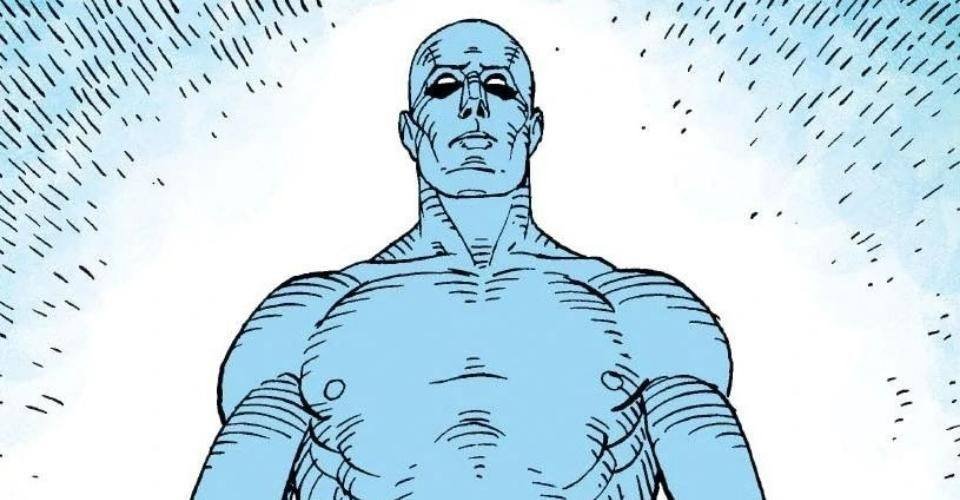
Publisher: DC Comics Time Travel Meter: Infinite
Dr. Manhattan turned into an energy being after he was exposed to a lab accident. The abilities he acquired manifested over time and slowly grew in power. Eventually, he turned into a being that could be everywhere at once and had the powers of a god. He could change reality to his wishes and create universes out of nothing.
With his omniscience came a significant shift in perspective. He no longer saw time in the same way as others. It was one large picture rather than a string of events, and he could place himself anywhere in that picture with just a thought. This has enabled the Doctor to travel to any moment he wished.
Since he is a timeless being, he doesn’t precisely need to travel anywhere. He can change realities and change futures instantly. He even destroys the DC universe and restarts it.
What is time to a God?
20 Most Powerful DC Characters Of All Time (Ranked) Fans Also Read
#8 Dr. Strange

Publisher: Marvel Comics Time Travel Meter: 3+
Stephen Strange is no Stranger to time travel. The Sorcerer Supreme is a master of the Mystic Arts and is a core member of the Avengers. He takes the lead on any threat of supernatural origin and is a more powerful practitioner of all things magic.
We see Dr. Strange using these magical objects to manipulate time on many occasions. The most famous would be the Eye of Agomotto or the Time Stone to see different futures. However, that is not the case in the comics. Dr. Strange discovers that the Book of Cagliostro can be used to travel time and that this method does not align with the scientific techniques in the other versions of time travel fiction.
Even without tools, Dr. Strange has been shown to simply travel time with her mystic arts.
#7 Superman

Publisher: DC Comics Time Travel Meter: 4+
There is seemingly very little that Superman can’t do. He is faster than light, can create a rift in reality just by punching it, and bench press the earth for five days straight. That is some next-level power. With the speeds he can achieve, it has been asked whether the Man of Steel can also travel time.
Superman has traveled time on many occasions. The how’s of this are rather sketchy and used to depend on the writer. The Superboy iteration could simply go back and forth in time with relative ease and could even carry people with him.
Even in one of the earlier Superman movies featuring George Reeves, we see the character go back in time but simply slow and reverse the earth’s rotation. He also uses his speed in the comic ‘Return to Krypton’ to go and visit Krypton before its destruction and meet his parent.
There truly is nothing that this man can’t do, huh?
All of Superman Powers Revealed Fans Also Read
#6 Green Lantern
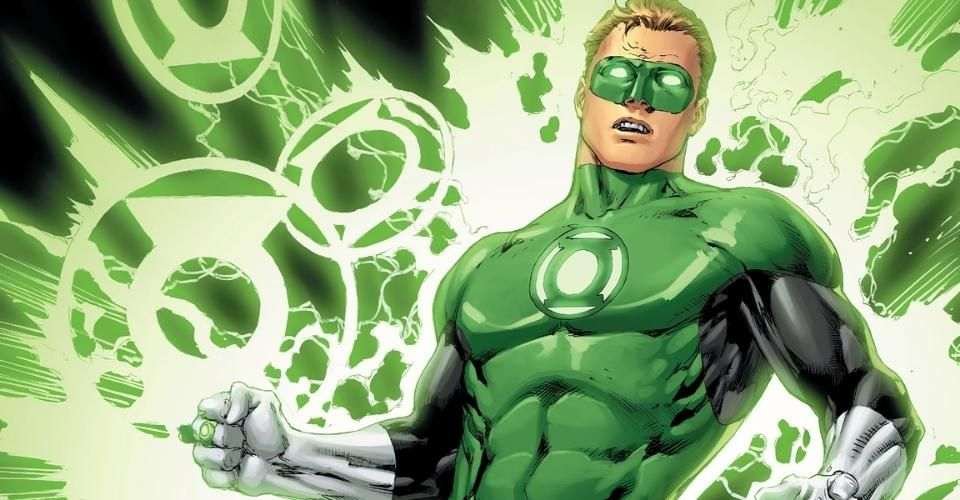
Publisher: DC Comics Time Travel Meter: 5+
The Lantern’s ring is only limited by its wielder’s imagination. From energy constructs to energy projection, the possibilities seem endless. Within its vast capabilities lies the power to manipulate and travel through time.
Hal Jordan has used the Ring to travel to the 70th century, and another GL Arisia Rrab uses the Ring’s power to send time through her and age quickly. We have to admit that the latter is rather strange.
Hal used his power in the comics to open a portal to the past so that he could send a few pterodactyls through it.
News Flash – comics books can be bizarre.

#5 Iron Lad
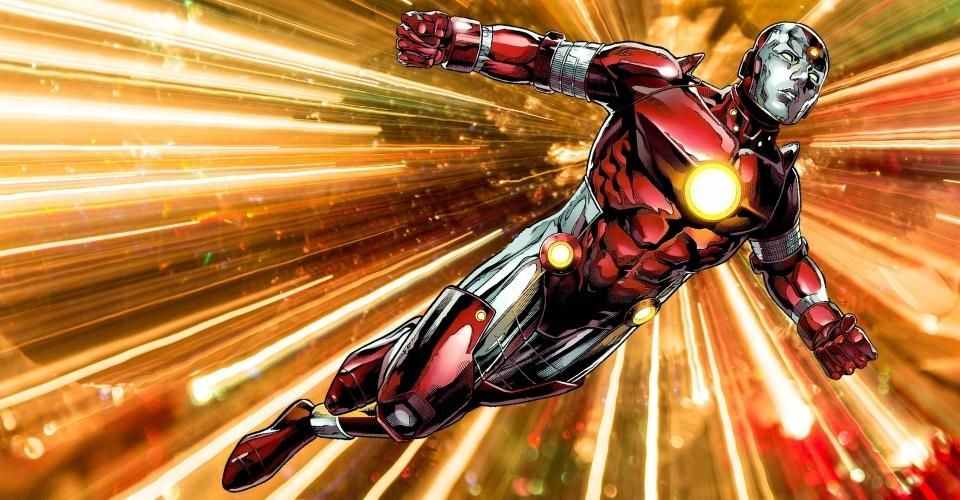
Publisher: Marvel Comics Time Travel Meter: 5+
Nathaniel Richards is a 30th-century genius and the younger version of Kang the Conqueror. Kang appeared to his younger self and saved him from a bully, thus giving him a glimpse of his future self and his armor similar to that of Iron Man. Upon seeing what he would turn into, Nathaniel renounced his destiny and decided to use his intellect to never become the evil version of himself.
The armor given to Nathaniel has neuro-kinetic capabilities and allows him to travel time, the same as Kang.
The most amazing time travel Adventure is when Iron Lad travels back in time to warn the Avengers of the oncoming dangers. Unable to get in touch with them, he helps the Young Avengers and even kills his older version in battle.

Publisher: Marvel Comics Time Travel Meter: 10+
Bishop is the great-grandson of the mutant Gateway, who could manipulate and travel through time. Although he does not possess the powers to do so himself. Bishop is a soldier from the future who can passively absorb energy and dispel it however he wants. He is often depicted holding an energy gun that would allow him to shoot his absorbed energy out as blasts.
Bishop uses time travel devices from the future similar to that of Cable to journey to different periods. He is usually seen traveling back in time from a dystopian future to help the X-men rewrite history.
Bishop was sent back in time to stop Legion from killing Magneto, but his failure to do so is what brought about the Age of Apokolips.
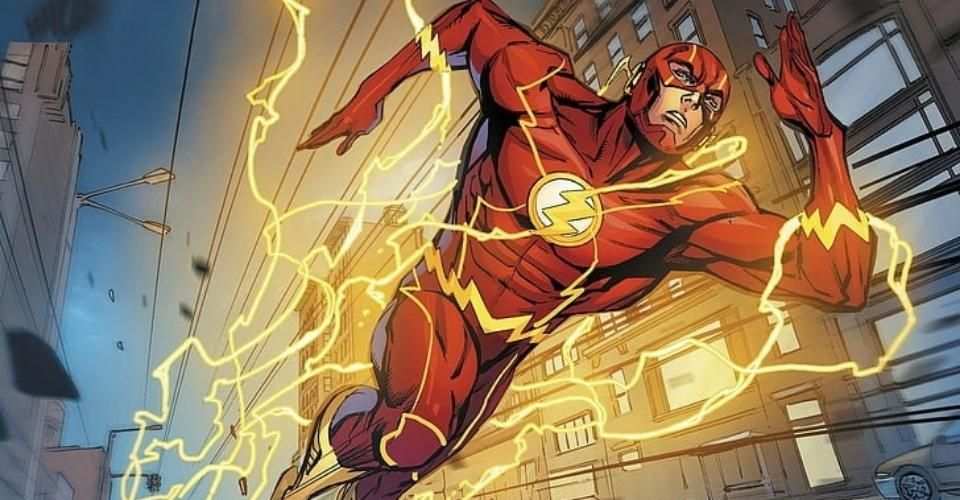
The fastest man on the planet has been known to play around a little too much with time. With the ability to run at a million times the speed of light, The Flash can alter the vibrations in his body to travel through time. He can do the same to travel through dimensions as well.
Not all versions of the Flash can achieve this feat, but Barry Allen and Wally West seem to do so easily. The most famous time-related adventure by a Flash is the Flashpoint paradox.
Due to his selfish needs, the Flash goes back in time and saves his mother, creating a massive rift and modifying the future to a world on the brink of war and destruction. Once in this new reality, Barry Allen realizes his mistake and works toward correcting his actions. He uses his time traveling abilities to go back in time and correct his errors.
This storyline is the most critical example of why the time stream is not to be tampered with.
Top 10 Fastest Superheroes From Marvel, DC (Ranked) Fans Also Read
#2 Booster Gold

Publisher: DC Comics Time Travel Meter: 20+
Booster Gold is from the 25th century Gotham, and unlike other future genii who come back in time, he just does so for fame. An underachiever in the future, Booster works as a janitor at the Museum of Superheroes. This is where he discovers much about the legendary heroes and their stories. He manages to steal a flight ring and Brainiac 5’s energy belt. He also takes Rip hunter’s time sphere, and it is with this that he travels back in time.
All his tools are still high-tech in the 20th century, and he uses them to make people believe that he is a superhero and simply works to become famous. Though initially shown to be a greedy showboat, Booster slowly learns the way of a true hero. He uses his abilities to travel through time and help change histories that lead to dystopian futures.
Booster uses his tech to go back in time and save Blue Beetle from getting murdered just moments before his death.

Publisher: Marvel Comics Time Travel Meter: 20+
Cable is the most famous time-traveling character in the Marvel Universe. He is the son of Scott Summers and a clone of Jean Grey from the future. He has traveled back in time numerous times to help the X-men with a threat or to prevent a dystopian future from occurring.
There are many versions of the character and various explanations for how he can travel time. The most common two are – he possesses inherent time travel abilities due to the techno-organic virus in his body, and the other is that he has a time travel device that looks like a watch which helps his travel time.
The best example of this feat is during the events of Ultimate X-men, where he comes back in time to warn and train Professor Xavier for their upcoming battle with Apokolips.
Honorable Mentions
- Guardians of the Galaxy
- Reed Richards
This brings us to the end of our time traveler’s list. If anything, we have learned that messing with time is bad news. However, do you think we could create a timeline where superheroes were real if we mess it up enough?
Interesting. Very interesting.
What Is the Ability to Control Time Called?
Chronokinesis is the ability to alter or control time with your mind. With it, you can travel through time or even stop it.
Which Superhero Can Travel Through Time?
The Flash can travel through time. He can vibrate his body at such speeds that he can phase through time. He can use some power to travel dimensions as well.
Which Marvel Hero Can Time Travel?
Kitty Pryde can time travel. She is the mutant that goes back in tune during the events of Days of Future Past in the comics.
Can Any Marvel Character Time Travel?
Yes, Iron Lad can time travel. He is the younger version of Kang the Conqueror and travels back in time to warn the Avengers of his future self.
What DC Characters Can Time Travel?
Booster Gold can time travel. He does so by making using Rip Hunter’s Time sphere that he stole from the 25th century.
Can Green Lanterns Time Travel?
Yes, Green Lanterns can time travel. Anything is possible as long as there is enough willpower. Hal Jordan once made a jet construct that could travel fast enough to enter the speed force, which means that he can probably travel through time.

- X (Twitter)
Jeremiah de Rozario is a professional songwriter and a comic nut. He has been an avid songwriter for over three years and has vast experience writing comics and pop culture. The people close to Jeremiah say he lives in a bit of fantasy land, as his career choices point us all in the same direction. Comics have taken Jeremiah on adventures since he was a child and continue to be where he draws most of his inspiration and life lessons. We know, weird! From stories of heartbreak, love, evil, and perseverance, comic books have it all. These fantasy stories have taken new and exciting turns on both paper and the big screen, and the little boy with his Incredible Hulk comic could not be happier. Jeremiah started his journey as a writer with Averagebeing and has written numerous detailed articles that deep dive into comic theories, TV shows, and the current happenings of this exciting world. If he isn't writing new songs, he is reading as many comic books as he can find. If you need a breakdown of your favorite comic hero or supervillain, Jeremiah is here to spill the tea.
Comments are closed.
Type above and press Enter to search. Press Esc to cancel.
Ad Blocker Detected!

The Top 10 Greatest Superpowers of All Time
Earlier, we counted down the best traditional superhero powers . In it, we listed powers like super strength, super speed, telekinesis, and mind control. Each of these powers was chosen because they were created more than 50 years ago and remain relevant to this day.
Over time, however, superhero powers have transformed from simple, easy-to-understand powers into complex ideas. And basically superheroes today function differently than they were 50 years ago. Although many superpowers could’ve made this list, only ten are good enough for it. If you permit me 5-6 minutes, I’d like to tell you what they are. Here are the greatest superpowers of all time.
10. Shapeshifting

For all the reasons that shapeshifting made my traditional superpowers list, it makes my greatest superpowers list. Shapeshifting does exactly what it sounds like it does. It allows the user to turn themselves into anyone they desire.
Shapeshifting is so important that it was the focal point for most of Fox’s X-Men franchise. For 19 years, we watched Mystique infiltrate and maneuver her way around government agencies, high-power organizations, and other mutants. And because of shapeshifting, she did so with ease.
9. Reactive Evolution
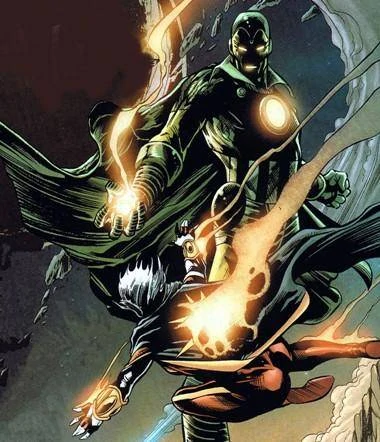
If a species could adapt to any environment they were put in, they could live forever.
Right? If human beings could, in one minute, adapt to a cold as cold as Neptune and then a warmth as warm as Venus in the next, we’d never go extinct. Unfortunately, we can’t, and as a result, one day, we will probably go extinct. This would be true unless we had one of the greatest superpowers of all time … reactive evolution.
Think about it. If we could adapt to any environment or situation, no matter how harsh, we’d be practically immune to change.
8. Precognition

Ask yourself where you’d be right now if you could see the future. How much different would your life be if you knew what was coming? Would you set yourself up forever? Perhaps pick the winning lottery numbers before they happen?
Or, would you even want to know what was coming? Would you want to know when you’d have children or when you’d die? Would you want to know whether or not you’d marry? These are all questions that most of us want to know the answer to but are too afraid to have answers.
Top 15 Most Powerful Mutants in the Marvel Universe (Ranked)
Precognition allows for a person, if they wanted to, to know all the above in the blink of an eye. The problem, as I’ve outlined, is that most don’t want to know.
Precognition is one of the greatest superpowers because it digs deep into our natural desires more than any other superpower on this list.
7. Plant Control

Maybe I’m a little biased, but I can’t help but think how fantastic it would be to have control over all plant life. Laugh if you must but know that controlling all plant life means I have an army that spans every square inch of the planet.
Controlling plant life is one of the greatest superpowers of all time because a) you’re army can be instantly replenished at any given time, b) you’re able to create an impenetrable fortress, and c) you can detain whoever you want whenever you want. If you require more convincing, know that possessing plant control equates to controlling the entirety of the planet.
6. Spider-Sense

Now we’re talking!
Although it may sound like precognition, don’t mistake it for precognition. Spider-Man’s Spider-Sense is a quick warning that only he feels to alert him of impending danger. More often than not, the warning comes in the form of squiggly lines above his head. I’m sure that you’ve seen it, or at the bare minimum, you’ve heard of it.
How Did Peter Parker Get His Powers? (Movies vs. Comics)
None of the superpowers he possesses have kept him as safe and alive as his Spider-Sense. In fact, it’s so important to the character that, aside from his quick wit, it practically defines him. Over the years, many have tried to replicate Spider-Sense, but none have perfected it in the way Spider-Man has.
5. Magnetic Control

Although magnetic control doesn’t sound all too great, remember that being able to control the Earth’s metal means that you can control most of the Earth. As shown in the first ‘X-Men’ movie , this includes the inner workings of human bodies.
Magnetic control is one of the greatest superhero powers…period. It allows for complete control of practically anything with a metal element in it. Locks. Guns. Tanks. People. You name it. You control it. This is why Magneto isn’t only one of the greatest X-Men enemies of all time but also one of the greatest villains of all time.
4. Invulnerability

You might notice that immortality isn’t on this list. Although it’s a good superpower, it’s just not something that’s overly desired. I mean, how much trouble, death, disease, and the like would a person live through if they lived forever? Probably too much.
That’s the reason that invulnerability and not immortality are on this list.
Imagine how it would be if you could walk around daily, knowing nothing could hurt you. War, gang violence, and beatdowns are of no concern because they couldn’t hurt you. And that’s not all. Invulnerability allows you to survive a house fire, severe hypothermia, and a giant tidal wave without so much as flinching.
Having Invulnerability means living a life without physical pain…and that’s pretty amazing.
3. Time Travel

Time Travel is so important in the realm of the greatest superpowers that we’ve actually made a list counting down the top time travellers .
Having the ability to time travel has fascinated our species for as long as we’ve imagined it. It’s been written about, studied, filmed, and attempted more times than I can count. Just think about “Back To The Future” and its many spin-offs.
None of the superheroes associated with time travel are as well-known as Cable. Cable is the offspring of Scott Summers and Madeline Pryor. As a time traveler, Cable travels back from his dystopian future to the present day to prevent a series of events that lead to his horrible future. Although the degree of his success is debatable, the fact that he has really great power is not.
As a product of the 1990s, Cable has more pouches and guns than any man should. In truth, he looks like a walking fanny pack.
2. Reality Warping

Very few knew or understood the power of reality warping before ‘ House of M .’ After it. However, the whole world stood at attention and begged for more. Reality Warping does exactly what you’d think it does…it allows the user to bend and create a reality that best suits them.
‘House of M’ saw Wanda Maximoff take the entirety of the Earth and create a new reality in which it lived in. In her reality, Mutants and not humans reigned supreme. By the end of the story, Wanda had lost control and reset the world. Unfortunately, it wasn’t without consequences. As a result of Wanda’s instability, the mutant population dropped from millions to just 198.
Kang, Scarlet Witch, and 13 Other Marvel Nexus Beings Explained
If it seems like reality warping is really dangerous, it’s because it is. That doesn’t, however, detract from how great a power it is.
1. Power Mimicry

At the end of the day, of all the great superpowers, none are as great as power mimicry. Unlike shapeshifting, which merely allows a person to copy the looks of another, power mimicry allows the person to copy whatever it is the other can do. It’s basically the power to end all powers.
Just look at Hope Summers .
Hope was the first born after the ‘House of M’ and was considered the savior of the mutant population. Because of this, she was protected at all costs by the remaining mutants, all the while being hunted by the non-mutants. Her power allowed her to be Cable in one minute and Wolverine in the next. Its flexibility forces me to put power mimicry as the number one of the greatest superpowers ever.
And that’s it. The greatest superpowers of all time. What do you think? What powers would make your greatest superpowers list?

I am a family man first and foremost. Everything that I do is for my family. They keep me focused and moving forward. I grew up loving comics, this hasn't changed and on occasion, I wonder if my wife thinks I'll never grow up. I hope you enjoy your stay at comicbasics.com.
- Write for Us
- Editorial Policy
- DMCA & Removal Policy
- Privacy Policy
- Depositphotos
Time Travel
What is time travel, heroes and villains with time travel.
There are 1,295 characters with Time Travel.

- Super Powers
- Feed History
- Collections
- Movies / TV
- Website Updates
- To-do / Bug list
- Buy me a Coffee
To revisit this article, visit My Profile, then View saved stories .
- Backchannel
- Newsletters
- WIRED Insider
- WIRED Consulting
Michio Kaku
The Super Power IssueA User's Guide to Time Travel
All it takes is a grasp of theoretical physics, control of the space-time continuum, and maybe a ball of cosmic string.
| The Super Power Issue
| Being Invisible
| The Antigravity Underground
| A User's Guide to Time Travel
| 8 Super Powers
Did the tech bubble burst in your face? Were you one of those unlucky outsiders who missed the Yahoo! IPO or got stuck with Enron stock long after the execs had dumped theirs? Wouldn't you like to be, just once, in the right place at the right time? Now you can. Follow a few simple instructions to relive the bull market and bail out just in time – then go on to march with Pericles or meet your great-great-great-grandchild.
Once confined to fantasy and science fiction, time travel is now simply an engineering problem. Physicists schooled in Newton's laws believed that time moved along a straight, steady course, like a speeding arrow. Then came Einstein in the early 1900s. His equations showed that time is more like a river. The more mass or energy you possess, the more the current around you varies. By moving at high velocity, for instance, you can make time slow down, and when you come to a stop, you'll be younger than if you'd remained at rest. Thus, a speedy spacecraft makes a fairly basic time machine.
Even after Einstein, most physicists believed the clock ticked in only one direction. While moving faster than the speed of light could, according to Einstein's equations, reverse time's arrow, such motion was impossible, because any object that reached that velocity would become infinite in mass. Trips to the past were preposterous.
Not anymore. Having examined Einstein's equations more closely, physicists now realize that the river of time may be diverted into a whirlpool – called a closed timelike curve – or even a fork leading to a parallel universe. In particular, the more mass you can concentrate at a single point, the more you can bend the flow.
In recent years, new designs for time machines have been flying off drawing boards at the world's top science labs. Exact specifications depend on where in time and space you wish to travel. You'll need a hefty CPU to solve the relevant equations for your machine's precise size, shape, motion, location, surroundings, and so on; the more accurately you can nail down these variables, the closer you'll come to your intended destination.
The designs that follow don't have the panache of Doc Brown's DeLorean in Back to the Future or even H. G. Wells' brass and quartz dream machine, but they do put time travel within reach of anyone with a couple of fast spaceships, a supercomputer, and a solar-system-scale machine shop. Warning: Time-space distortions may not be stable and may collapse as you enter, so approach them at your own risk. Also, when going back in time, do not – repeat – do not kill your parents before you are born. Wired takes no responsibility for parallel universes in which you find yourself trapped for eternity.

By Matt Burgess

By Dell Cameron

By Ryan Waniata

By Matt Kamen
Throne Plates

When Carl Sagan was writing his 1985 novel Contact , he asked Caltech physicist Kip Thorne how to abbreviate the lengthy flight time required for a trip to a distant star. Thorne suggested a wormhole, a shortcut through space-time that almost certainly exists as a consequence of Einsteinian principles, although one has yet to be detected. A few years later, Thorne suggested that a wormhole's entrances could be positioned in space and time as desired. Unlike some other time machines, this Thorne-inspired design allows round trips. However, it can't take you back to a time before the machine was built. Here's how it works:
•Obtain four large conductive plates at least a few miles in diameter. Arrange them in parallel, very close together. The space between each plate will teem with negative energy – a proven phenomenon known as the Casimir effect – creating slices of identical space-time. •Separate the plates into two pairs. A wormhole will connect the pairs like an umbilical cord. •Place one pair in a rocket ship and accelerate to almost the speed of light, preferably in a circular path so the rocket doesn't stray too far. Time will nearly freeze for that set while the other, still on the ground, ages at the usual rate. With each passing moment, the space-borne plates will go farther back in time relative to the others. •When a sufficient amount of time has passed – preferably decades – step between the earthbound plates. You'll immediately be transported back in time and across space to the other pair.
Fine print : To activate Thorne plates, the distance between each plate must be less than the width of an atom. The resulting wormhole will be equally small, so getting in and out might be difficult. To widen the portal, some scientists suggest using a laser to inject immense amounts of negative energy. In addition, Thorne believes that radiation effects created by gravitons, or particles of gravity, might fry you as you enter the wormhole. According to string theory, however, this probably won't happen, so it's scant reason to cancel your trip.

Many scientists believe the big bang that created the universe left behind cosmic strings – thin, infinitely long filaments of compressed matter. In 1991, Princeton physicist J. Richard Gott discovered that two of these structures, arranged in parallel and moving in opposite directions, would warp space-time to allow travel to the past. He later reworked the idea to involve a single cosmic-string loop. A Gott loop can take you back in time but not forward. The guide to building your own:
•Scan the galaxy for a loop of cosmic string. •When you find one, fly close to it in a massive spaceship. Use the ship's gravity to shape the string into a rectangle roughly 54,000 light-years long and .01 light-years wide. Gravity exerted by the longer sides of the rectangle will cause it to collapse, bringing the sides closer and closer together at nearly the speed of light. •As the two sides approach within 10 feet of each other, circle them in a smaller ship. When you return to the start of the circle, you will have traveled back in time.
Fine print : To take you back one year, the string must weigh about half as much as the Milky Way galaxy. You'll need a mighty big spaceship to make that rectangle.
Gott Shell In essence, a Gott shell is a huge concentration of mass. The shell's sheer density creates a gravitational field that slows down the clock for anyone enclosed within it. Outside, time rolls along at its familiar pace, but inside, it creeps. Thus the Gott shell is useful for travel into the future only. If you're planning a jaunt to the past using a Gott loop, you might want to bring along a Gott shell for the return trip. What to do, step by step:
•Salvage scrap planetary matter to assemble a mass equal to or greater than Jupiter's. •Working slowly so as not to produce sudden gravitational disturbances, assemble the matter around yourself in a sphere. For your comfort – and to avoid inadvertently creating a black hole later in the process – be sure to leave a cavity larger than 18 feet in diameter at the center. •Stock the cockpit with lots of food, drink, diversions, and back issues of Wired. Your journey might take a while. •Using a high-powered energy source, compress the shell. The greater the compression, the faster you'll be transported – up to five times the pace of ordinary time for a Jupiter-sized mass, faster for a larger ball of matter. •After waiting the desired interval – several decades works best – slowly decompress the shell and emerge. You'll find yourself in the same place but in a distant epoch. Welcome to the future.
Fine print : This is a relatively slow method of time travel, and life inside the shell could become tedious.
Van Stokum Cylinder

Mass and energy act on space-time like a rock thrown into a pond: the bigger the rock, the bigger the ripples. Physicist W. J. van Stockum realized in 1937 that an immense cylinder spinning at near-light speed will stir space-time as though it were molasses, pulling it along as the cylinder turns. Although Van Stockum himself didn't recognize it, anyone orbiting such a cylinder in the direction of the spin will be caught in the current and, from the perspective of a distant observer, exceed the speed of light. The result: Time flows backward. Circle the cylinder in the other direction with just the right trajectory, and this machine can take you into the future as well. How it works:
•Using a high-performance spacecraft with tractor beams, or at least heavy-duty cables, trawl the galaxy gathering planets, asteroids, comets, and the like. Collect as much matter as you can. •With a galactic-scale forge, extrude the planetary matter into a long, dense cylinder. •Use an industrial-strength electromagnetic field to spin the cylinder along its central axis. Accelerate it to the speed corresponding to your destination time. •Orbit the cylinder in the direction of the spin. With each circuit you make, you'll return at a time before you left.
Fine print : The cylinder must be infinitely long, which could add slightly to its cost.

When Karl Schwarzschild solved Einstein's equations in 1917, he found that stars can collapse into infinitesimally small points in space – what we now call black holes. Four decades later, physicist Roy Kerr discovered that some stars are saved from total collapse and become rotating rings. Kerr didn't regard these rings as time machines. However, because their intense gravity distorts space-time, and because they permit large objects to enter on one side and exit on the other in one piece, Kerr-type black holes can serve as portals to the past or the future. If finding one with the proper dimensions is too much trouble, you can always build one yourself:
•Gather enough matter to equal Jupiter's mass. •Compress it into a ring about 5 feet in diameter. This can put a lot of stress on mechanical tools, so a high-energy electromagnetic field is recommended. •As you compress the ring, set it spinning. Increase its velocity to nearly the speed of light. A black hole will form at its center. •Step through the hole and you'll be transported instantly to another time (and, possibly, place), potentially as far back as the big bang or as far forward as the end of the universe as we know it. Bon voyage!
Fine print : The Kerr ring is a one-way ticket. The black hole's gravity is so great that, once you step through it, you won't be able to return.

Leila Sloman

Paul Sutter, Ars Technica

Lyndie Chiou

Charlie Wood

Rhett Allain

Thomas Zurbuchen

Dennis Mersereau
Screen Rant
10 marvel movie characters who time traveled (& how).

Your changes have been saved
Email Is sent
Please verify your email address.
You’ve reached your account maximum for followed topics.
Avengers: Endgame's Time Travel Explained (Properly)
10 marvel movie superheroes way weaker than powers suggest, i blame the mcu's very first phase 4 movie for the franchise's biggest post-endgame problem.
- Time travel has been a key element in various Marvel movie franchises, allowing characters to learn new information, affect their own futures, and even save the entire universe.
- The MCU, Fox's X-Men Universe, and Marvel Television's Agents of SHIELD have all utilized time travel in a variety of storylines, with many different characters having traveled through time.
- Loki, Wolverine, Deadpool, Ms. Marvel, and Kang the Conqueror are just a few of the iconic Marvel characters who have used time travel to complete various missions.
Time travel has been used by various characters in the MCU and other Marvel movie franchises, with many different means of traveling through time having been introduced into Marvel's live-action superhero universes. While many early projects in Marvel movie franchises dealt with smaller-scale stories and introductions to now-prominent superheroes and villains, larger concepts have been introduced in recent years, expanding the worlds of these franchises beyond belief. The complex concept of the multiverse has been explored in the MCU and Sony's Spider-Man Universe, but the idea of time travel has also been used as a vehicle to drive the overarching narratives of these franchises forward.
Although most prominently seen in the Marvel Cinematic Universe, Fox's X-Men Universe also included several time travel narratives. While exploring the idea of time travel had the potential to feel like a gimmick in some instances, it has always been used organically in storylines, allowing characters to learn new information, affect their own futures, and, in some cases, save the entire universe. Time travel has been a crucial element in the storylines of many characters, both in the MCU and other Marvel franchises , and studios have often found clever and unexpected ways to throw their characters through time.
Outside the main MCU continuity and Fox's X-Men Universe, time travel was used throughout Marvel Television's Agents of SHIELD , as Phil Coulson and his team journeyed to a variety of different timelines, particularly in the series' epic final season.
Avengers: Endgame sees the heroes time travel in a bid to undo Thanos' snap. And it's complicated. We explain all the loops, paradoxes and plot holes.
10 Time Travel Was A Huge Part Of Loki's Storyline
Loki season 1 (2021) & loki season 2 (2023).
Time travel was never a key element in the original storyline for Tom Hiddleston's Asgardian God of Mischief, Loki, but the Loki series on Disney+ explored the concept in great detail. After escaping from the Avengers during Endgame , the MCU's current variant of Loki was taken captive by the Time Variance Authority, an organization that exists outside of time and is able to travel to any time period through the use of TemPads and Time Doors. Loki season 1 also saw Loki travel to the end of time, coming face-to-face with the creator of the TVA, Jonathan Majors' He Who Remains, a variant of Multiverse Saga villain Kang the Conqueror .
Loki season 2 expanded on this idea even further, as Loki himself was imbued with a time traveling ability known as "time-slipping". Initially, this was shown to be a violent and unpredictable process, shifting him between the past, present, and future seemingly randomly. However, Loki soon learns to control his time-slipping ability, which becomes paramount in him saving the multiverse in Loki season 2's finale . After using his time-slipping to revisit He Who Remains before his death, and say a final farewell to Mobius and Sylvie, Loki transforms into the God of Time , taking his final position at the end of time, watching over the infinite branches of the multiverse.
9 Doctor Strange Used The Time Stone In The MCU's Infinity Saga
Doctor strange (2016) & avengers: infinity war (2018).
Benedict Cumberbatch's MCU debut in 2016's Doctor Strange saw him quickly harness the power of the Time Stone, an Infinity Stone that had command over the concept of time. Using the stone, Strange turned back time to thwart the invasion efforts of Dormammu and his zealots, and later stuck himself and Dormammu in a time loop in an effort to bargain with the ruler of the Dark Dimension. Later, in Avengers: Infinity War , Doctor Strange uses the Time Stone while waiting for Thanos on Titan in order to look forward in time to see possible futures and try and plan a way to defeat the Mad Titan.
8 Wolverine's Consciousness Was Sent To 1973 In Days Of Future Past
X-men: days of future past (2014).
2014's X-Men: Days of Future Past was the first project in Fox's X-Men Universe to explore the concept of time travel, but rather than an entire individual being thrown back in time, Kitty Pryde uses her ability to send Wolverine's consciousness back into his body in 1973. This allows Hugh Jackman's Wolverine to retain the knowledge of the future, and enlist the help of the younger Professor X, Magneto, Beast, and Mystique in stopping the development of the Sentinel robots at the very start, preventing a destructive future war. When Wolverine returned to the present day, he still remembered the war that never happened, having changed his own timeline .
7 Cable Traveled From The Future To Save His Family
Deadpool 2 (2018).
Taking place in the new rebooted version of Fox's X-Men Universe, 2018's Deadpool 2 saw Josh Brolin's Cable travel back in time from the future in an effort to prevent the deaths of his family at the hands of a dangerous mutant. Ryan Reynolds' Deadpool had inadvertently formed a partnership with said mutant, young Russell Collins, so initially butted heads with Cable. Even so, Cable eventually sacrificed his only means of traveling home in order to save Deadpool's life, safe in the knowledge that the future had already been changed, and his family would be safe. Cable time traveled using a futuristic device that resembled a wristwatch.
Josh Brolin also portrayed the Mad Titan Thanos in the MCU proper. It's possible that he could return in Deadpool 3 or beyond to portray Cable alongside Ryan Reynolds' Deadpool, having previously signed a four-picture deal with Fox, but Marvel Studios has yet to confirm his involvement in future MCU projects.
6 Deadpool May Have Caused Many Problems With His Time Traveling
While Cable's time traveling device had been exhausted, Yukio and Negasonic Teenage Warhead fixed the device in Deadpool 2's post-credits scene, allowing the Merc-with-a-Mouth himself to travel back through his own history. Deadpool used his new time traveling power to save Vanessa from her death at the beginning of the film, avoid human X-Force member Peter's gruesome death, repeatedly shoot the version of Deadpool from 2009's X-Men Origins: Wolverine and meet Hugh Jackman's Wolverine for the first time, and shoot Ryan Reynolds in the head moments after reading the script for 2011's reviled Green Lantern . This is sure to have repercussions for Reynolds' upcoming MCU debut in 2024's Deadpool 3 .
5 Ms. Marvel Broke The MCU's Time Travel Rules In Phase 4
Ms. marvel (2022).
The MCU's time travel rules were laid out fairly clearly in 2019's Avengers: Endgame , suggesting that a character time traveling would create a branching timeline, rather than affecting their own personal timeline. However, Phase 4's Ms. Marvel broke this rule , as Iman Vellani's Kamala Khan was transported back in time by her mystical bangle. Kamala found herself in 1942 during the Partition of India. There, Kamala used her hard-light ability to guide her grandmother back to her great-grandfather, ensuring her own birth many decades later. This causal loop broke all of Endgame's rules, but provided an exciting story for Ms. Marvel in her MCU debut .
2023's The Marvels confirmed that Kamala Khan's bangle is one of two Quantum Bands in the MCU, adapted from the powerful Marvel Comics devices wielded by Nova, Phyla-Vell, and Wendell Vaughn, a.k.a. Quasar.
4 Thanos & The Black Order Came Forward In Time To Battle The Avengers
Avengers: endgame (2019).
While the majority of Avengers: Endgame's time travel focused on the Avengers themselves traveling through time to collect the Infinity Stones, the epic Phase 3 film also saw a major MCU villain travel through time. In an alternate 2014, the Mad Titan Thanos caught wind of the Avengers' actions, and, after capturing the future version of Nebula, used Pym Particles to transport himself and his entire army into the future of the MCU's 2023. Once there, Thanos immediately attacked and destroyed Avengers HQ, and fought the Earth's Mightiest Heroes in an effort to retrieve the completed Infinity Gauntlet, though he and his fleet were ultimately eradicated by Tony Stark.
3 Kang The Conqueror Is The MCU's Master Of Time Travel
Ant-man & the wasp: quantumania (2023).
After Thanos' demise, Marvel Studios introduced Jonathan Majors' Kang the Conqueror as the MCU's next primary supervillain. In Marvel Comics, Kang is a master of time travel, having used his time traveling equipment to create many different versions of himself throughout time. In the MCU, his story has been slightly changed, as Kang uses his machinery to travel between various different timelines and realities , though there are still an infinite number of Kang variants posing a huge threat to the future of the MCU. Recent controversies surrounding Jonathan Majors have thrown Kang's MCU future into jeopardy, but currently, he is still set to appear in 2026's Avengers: The Kang Dynasty .
Kang the Conqueror's backstory and motivations have yet to be explored in detail, but 2023's Ant-Man and the Wasp: Quantumania revealed that he has already obliterated many alternate timelines and realities in the MCU, proving he is a major threat to the franchise's heroes.
2 The Avengers Saved The Universe By Time Traveling
Perhaps the most notable use of time travel in the MCU's history occurred during Avengers: Endgame , which picked up five years after Thanos snapped his fingers and wiped out half the population of the universe. Realizing time works unpredictably in the Quantum Realm, Scott Lang revealed to the surviving Avengers that the Quantum Realm could be used to travel through time, allowing the heroes to collect the Infinity Stones from the MCU's history , and use them to bring their fallen friends back. This plan ultimately succeeds, with the Avengers traveling to key moments in the MCU's past, though it came at the cost of Black Widow and Iron Man's lives.
During Avengers: Endgame's Time Heist, Scott Lang's Ant-Man, Bruce Banner's Smart Hulk, Steve Rogers' Captain America, and Tony Stark's Iron Man journey to 2012's New York to acquire the Time Stone, Mind Stone, and Space Stone. Rogers and Stark later travel to 1970's Camp Lehigh after failing to retreive 2012's Tesseract. Thor and Rocket travel to 2013's Asgard and collect the Reality Stone from Jane Foster, while Nebula and Rhodey's War Machine collect the Power Stone from 2014's Morag before Peter Quill can. Natasha Romanoff's Black Widow and Clint Barton's Hawkeye travel to 2014's Vormir for the Soul Stone, with Romanoff sacrificing herself to Barton can return with the stone.
1 Captain America Retired By Time Traveling To The Past
After the Time Heist and the Battle of Earth, Earth's Mightiest Heroes took a moment to memorialize their fallen friends, Natasha Romanoff, Vision, and Tony Stark, before Steve Rogers embarked on his final mission: returning the collected Infinity Stones to their original timelines. Rogers set out on this mission alone, returning each stone to where they came from, but instead of returning as planned, he decided to retire as Captain America and remain in the past with his long-lost love Peggy Carter. This was the perfect ending for Steve Rogers' Captain America in the MCU , and proved just how valuable time travel was in completing his Marvel journey.
Key Release Dates
Blade (2025), avengers: the kang dynasty, avengers: secret wars.

Digital Series
New videos to celebrate the real-life heroes in our lives!

Culture & Lifestyle
Voting for the 25th annual Webby Awards is open until Thursday, May 6!

Meet Alex van Breukelen, a retired Marine, and his equally heroic service dog Tara!
More From Marvel Make Me A Hero
More digital series.


- Table of Contents
- New in this Archive
- Chronological
- Editorial Information
- About the SEP
- Editorial Board
- How to Cite the SEP
- Special Characters
- Support the SEP
- PDFs for SEP Friends
- Make a Donation
- SEPIA for Libraries
- Entry Contents
Bibliography
Academic tools.
- Friends PDF Preview
- Author and Citation Info
- Back to Top
Time Travel and Modern Physics
Time travel has been a staple of science fiction. With the advent of general relativity it has been entertained by serious physicists. But, especially in the philosophy literature, there have been arguments that time travel is inherently paradoxical. The most famous paradox is the grandfather paradox: you travel back in time and kill your grandfather, thereby preventing your own existence. To avoid inconsistency some circumstance will have to occur which makes you fail in this attempt to kill your grandfather. Doesn't this require some implausible constraint on otherwise unrelated circumstances? We examine such worries in the context of modern physics.
1. A Botched Suicide
2. why do time travel suicides get botched, 3. topology and constraints, 4. the general possibility of time travel in general relativity, 5. two toy models, 6. remarks and limitations on the toy models, 7. slightly more realistic models of time travel, 8. even if there are constraints, so what, 9. quantum mechanics to the rescue, 10. conclusions, other internet resources, related entries.
You are very depressed. You are suicidally depressed. You have a gun. But you do not quite have the courage to point the gun at yourself and kill yourself in this way. If only someone else would kill you, that would be a good thing. But you can't really ask someone to kill you. That wouldn't be fair. You decide that if you remain this depressed and you find a time machine, you will travel back in time to just about now, and kill your earlier self. That would be good. In that way you even would get rid of the depressing time you will spend between now and when you would get into that time machine. You start to muse about the coherence of this idea, when something amazing happens. Out of nowhere you suddenly see someone coming towards you with a gun pointed at you. In fact he looks very much like you, except that he is bleeding badly from his left eye, and can barely stand up straight. You are at peace. You look straight at him, calmly. He shoots. You feel a searing pain in your left eye. Your mind is in chaos, you stagger around and accidentally enter a strange looking cubicle. You drift off into unconsciousness. After a while, you can not tell how long, you drift back into consciousness and stagger out of the cubicle. You see someone in the distance looking at you calmly and fixedly. You realize that it is your younger self. He looks straight at you. You are in terrible pain. You have to end this, you have to kill him, really kill him once and for all. You shoot him, but your eyesight is so bad that your aim is off. You do not kill him, you merely damage his left eye. He staggers off. You fall to the ground in agony, and decide to study the paradoxes of time travel more seriously.
The standard worry about time travel is that it allows one to go back and kill one's younger self and thereby create paradox. More generally it allows for people or objects to travel back in time and to cause events in the past that are inconsistent with what in fact happened. (See e.g., Gödel 1949, Earman 1972, Malament 1985a&b, Horwich 1987.) A stone-walling response to this worry is that by logic indeed inconsistent events can not both happen. Thus in fact all such schemes to create paradox are logically bound to fail. So what's the worry?
Well, one worry is the question as to why such schemes always fail. Doesn't the necessity of such failures put prima facie unusual and unexpected constraints on the actions of people, or objects, that have traveled in time? Don't we have good reason to believe that there are no such constraints (in our world) and thus that there is no time travel (in our world)? We will later return to the issue of the palatability of such constraints, but first we want to discuss an argument that no constraints are imposed by time travel.
Wheeler and Feynman (1949) were the first to claim that the fact that nature is continuous could be used to argue that causal influences from later events to earlier events, as are made possible by time travel, will not lead to paradox without the need for any constraints. Maudlin (1990) showed how to make their argument precise and more general, and argued that nonetheless it was not completely general.
Imagine the following set-up. We start off having a camera with a black and white film ready to take a picture of whatever comes out of the time machine. An object, in fact a developed film, comes out of the time machine. We photograph it, and develop the film. The developed film is subsequently put in the time machine, and set to come out of the time machine at the time the picture is taken. This surely will create a paradox: the developed film will have the opposite distribution of black, white, and shades of gray, from the object that comes out of the time machine. For developed black and white films (i.e. negatives) have the opposite shades of gray from the objects they are pictures of. But since the object that comes out of the time machine is the developed film itself it we surely have a paradox.
However, it does not take much thought to realize that there is no paradox here. What will happen is that a uniformly gray picture will emerge, which produces a developed film that has exactly the same uniform shade of gray. No matter what the sensitivity of the film is, as long as the dependence of the brightness of the developed film depends in a continuous manner on the brightness of the object being photographed, there will be a shade of gray that, when photographed, will produce exactly the same shade of gray on the developed film. This is the essence of Wheeler and Feynman's idea. Let us first be a bit more precise and then a bit more general.
For simplicity let us suppose that the film is always a uniform shade of gray (i.e. at any time the shade of gray does not vary by location on the film). The possible shades of gray of the film can then be represented by the (real) numbers from 0, representing pure black, to 1, representing pure white.
Let us now distinguish various stages in the chronogical order of the life of the film. In stage S 1 the film is young; it has just been placed in the camera and is ready to be exposed. It is then exposed to the object that comes out of the time machine. (That object in fact is a later stage of the film itself). By the time we come to stage S 2 of the life of the film, it has been developed and is about to enter the time machine. Stage S 3 occurs just after it exits the time machine and just before it is photographed. Stage S 4 occurs after it has been photographed and before it starts fading away. Let us assume that the film starts out in stage S 1 in some uniform shade of gray, and that the only significant change in the shade of gray of the film occurs between stages S 1 and S 2 . During that period it acquires a shade of gray that depends on the shade of gray of the object that was photographed. I.e., the shade of gray that the film acquires at stage S 2 depends on the shade of gray it has at stage S 3 . The influence of the shade of gray of the film at stage S 3 , on the shade of gray of the film at stage S 2 , can be represented as a mapping, or function, from the real numbers between 0 and 1 (inclusive), to the real numbers between 0 and 1 (inclusive). Let us suppose that the process of photography is such that if one imagines varying the shade of gray of an object in a smooth, continuous manner then the shade of gray of the developed picture of that object will also vary in a smooth, continuous manner. This implies that the function in question will be a continuous function. Now any continuous function from the real numbers between 0 and 1 (inclusive) to the real numbers between 0 and 1 (inclusive) must map at least one number to itself. One can quickly convince oneself of this by graphing such functions. For one will quickly see that any continuous function f from [0,1] to [0,1] must intersect the line x = y somewhere, and thus there must be at least one point x such that f ( x )= x . Such points are called fixed points of the function. Now let us think about what such a fixed point represents. It represents a shade of gray such that, when photographed, it will produce a developed film with exactly that same shade of gray. The existence of such a fixed point implies a solution to the apparent paradox.
Let us now be more general and allow color photography. One can represent each possible color of an object (of uniform color) by the proportions of blue, green and red that make up that color. (This is why television screens can produce all possible colors.) Thus one can represent all possible colors of an object by three points on three orthogonal lines x , y and z , that is to say, by a point in a three-dimensional cube. This cube is also known as the ‘Cartesian product’ of the three line segments. Now, one can also show that any continuous map from such a cube to itself must have at least one fixed point. So color photography can not be used to create time travel paradoxes either!
Even more generally, consider some system P which, as in the above example, has the following life. It starts in some state S 1 , it interacts with an object that comes out of a time machine (which happens to be its older self), it travels back in time, it interacts with some object (which happens to be its younger self), and finally it grows old and dies. Let us assume that the set of possible states of P can be represented by a Cartesian product of n closed intervals of the reals, i.e., let us assume that the topology of the state-space of P is isomorphic to a finite Cartesian product of closed intervals of the reals. Let us further assume that the development of P in time, and the dependence of that development on the state of objects that it interacts with, is continuous. Then, by a well-known fixed point theorem in topology (see e.g., Hocking and Young 1961, p 273), no matter what the nature of the interaction is, and no matter what the initial state of the object is, there will be at least one state S 3 of the older system (as it emerges from the time travel machine) that will influence the initial state S 1 of the younger system (when it encounters the older system) so that, as the younger system becomes older, it develops exactly into state S 3 . Thus without imposing any constraints on the initial state S 1 of the system P , we have shown that there will always be perfectly ordinary, non-paradoxical, solutions, in which everything that happens, happens according to the usual laws of development. Of course, there is looped causation, hence presumably also looped explanation, but what do you expect if there is looped time?
Unfortunately, for the fan of time travel, a little reflection suggests that there are systems for which the needed fixed point theorem does not hold. Imagine, for instance, that we have a dial that can only rotate in a plane. We are going to put the dial in the time machine. Indeed we have decided that if we see the later stage of the dial come out of the time machine set at angle x , then we will set the dial to x +90, and throw it into the time machine. Now it seems we have a paradox, since the mapping that consists of a rotation of all points in a circular state-space by 90 degrees does not have a fixed point. And why wouldn't some state-spaces have the topology of a circle?
However, we have so far not used another continuity assumption which is also a reasonable assumption. So far we have only made the following demand: the state the dial is in at stage S 2 must be a continuous function of the state of the dial at stage S 3 . But, the state of the dial at stage S 2 is arrived at by taking the state of the dial at stage S 1 , and rotating it over some angle. It is not merely the case that the effect of the interaction, namely the state of the dial at stage S 2 , should be a continuous function of the cause, namely the state of the dial at stage S 3 . It is additionally the case that path taken to get there, the way the dial is rotated between stages S 1 and S 2 must be a continuous function of the state at stage S 3 . And, rather surprisingly, it turns out that this can not be done. Let us illustrate what the problem is before going to a more general demonstration that there must be a fixed point solution in the dial case.
Forget time travel for the moment. Suppose that you and I each have a watch with a single dial neither of which is running. My watch is set at 12. You are going to announce what your watch is set at. My task is going to be to adjust my watch to yours no matter what announcement you make. And my actions should have a continuous (single valued) dependence on the time that you announce. Surprisingly, this is not possible! For instance, suppose that if you announce “12”, then I achieve that setting on my watch by doing nothing. Now imagine slowly and continuously increasing the announced times, starting at 12. By continuity, I must achieve each of those settings by rotating my dial to the right. If at some point I switch and achieve the announced goal by a rotation of my dial to the left, I will have introduced a discontinuity in my actions, a discontinuity in the actions that I take as a function of the announced angle. So I will be forced, by continuity, to achieve every announcement by rotating the dial to the right. But, this rotation to the right will have to be abruptly discontinued as the announcements grow larger and I eventually approach 12 again, since I achieved 12 by not rotating the dial at all. So, there will be a discontinuity at 12 at the latest. In general, continuity of my actions as a function of announced times can not be maintained throughout if I am to be able to replicate all possible settings. Another way to see the problem is that one can similarly reason that, as one starts with 12, and imagines continuously making the announced times earlier, one will be forced, by continuity, to achieve the announced times by rotating the dial to the left. But the conclusions drawn from the assumption of continuous increases and the assumption of continuous decreases are inconsistent. So we have an inconsistency following from the assumption of continuity and the assumption that I always manage to set my watch to your watch. So, a dial developing according to a continuous dynamics from a given initial state, can not be set up so as to react to a second dial, with which it interacts, in such a way that it is guaranteed to always end up set at the same angle as the second dial. Similarly, it can not be set up so that it is guaranteed to always end up set at 90 degrees to the setting of the second dial. All of this has nothing to do with time travel. However, the impossibility of such set ups is what prevents us from enacting the rotation by 90 degrees that would create paradox in the time travel setting.
Let us now give the positive result that with such dials there will always be fixed point solutions, as long as the dynamics is continuous. Let us call the state of the dial before it interacts with its older self the initial state of the dial. And let us call the state of the dial after it emerges from the time machine the final state of the dial. We can represent the possible initial and final states of the dial by the angles x and y that the dial can point at initially and finally. The set of possible initial plus final states thus forms a torus. (See figure 1.)
Suppose that the dial starts at angle I . The initial angle I that the dial is at before it encounters its older self, and the set of all possible final angles that the dial can have when it emerges from the time machine is represented by the circle I on the torus (see figure 1). Given any possible angle of the emerging dial the dial initially at angle I will develop to some other angle. One can picture this development by rotating each point on I in the horizontal direction by the relevant amount. Since the rotation has to depend continuously on the angle of the emerging dial, ring I during this development will deform into some loop L on the torus. Loop L thus represents the angle x that the dial is at when it is thrown into the time machine, given that it started at angle I and then encountered a dial (its older self) which was at angle y when it emerged from the time machine. We therefore have consistency if x = y for some x and y on loop L . Now, let loop C be the loop which consists of all the points on the torus for which x = y . Ring I intersects C at point < i , i >. Obviously any continuous deformation of I must still intersect C somewhere. So L must intersect C somewhere, say at < j , j >. But that means that no matter how the development of the dial starting at I depends on the angle of the emerging dial, there will be some angle for the emerging dial such that the dial will develop exactly into that angle (by the time it enters the time machine) under the influence of that emerging dial. This is so no matter what angle one starts with, and no matter how the development depends on the angle of the emerging dial. Thus even for a circular state-space there are no constraints needed other than continuity.
Unfortunately there are state-spaces that escape even this argument. Consider for instance a pointer that can be set to all values between 0 and 1, where 0 and 1 are not possible values. That is, suppose that we have a state-space that is isomorphic to an open set of real numbers. Now suppose that we have a machine that sets the pointer to half the value that the pointer is set at when it emerges from the time machine.
Suppose the pointer starts at value I . As before we can represent the combination of this initial position and all possible final positions by the line I . Under the influence of the pointer coming out of the time machine the pointer value will develop to a value that equals half the value of the final value that it encountered. We can represent this development as the continuous deformation of line I into line L , which is indicated by the arrows in Figure 2. This development is fully continuous. Points < x , y > on line I represent the initial position x = I of the (young) pointer, and the position y of the older pointer as it emerges from the time machine. Points < x , y > on line L represent the position x that the younger pointer should develop into, given that it encountered the older pointer emerging from the time machine set at position y . Since the pointer is designed to develop to half the value of the pointer that it encounters, the line L corresponds to x = 1 / 2 y . We have consistency if there is some point such that it develops into that point, if it encounters that point. Thus, we have consistency if there is some point < x , y > on line L such that x = y . However, there is no such point: lines L and C do not intersect. Thus there is no consistent solution, despite the fact that the dynamics is fully continuous.
Of course if 0 were a possible value L and C would intersect at 0. This is surprising and strange: adding one point to the set of possible values of a quantity here makes the difference between paradox and peace. One might be tempted to just add the extra point to the state-space in order to avoid problems. After all, one might say, surely no measurements could ever tell us whether the set of possible values includes that exact point or not. Unfortunately there can be good theoretical reasons for supposing that some quantity has a state-space that is open: the set of all possible speeds of massive objects in special relativity surely is an open set, since it includes all speeds up to, but not including, the speed of light. Quantities that have possible values that are not bounded also lead to counter examples to the presented fixed point argument. And it is not obvious to us why one should exclude such possibilities. So the argument that no constraints are needed is not fully general.
An interesting question of course is: exactly for which state-spaces must there be such fixed points. We do not know the general answer. (But see Kutach 2003 for more on this issue.)
Time travel has recently been discussed quite extensively in the context of general relativity. Time travel can occur in general relativistic models in which one has closed time-like curves (CTC's). A time like curve is simply a space-time trajectory such that the speed of light is never equalled or exceeded along this trajectory. Time-like curves thus represent the possible trajectories of ordinary objects. If there were time-like curves which were closed (formed a loop), then travelling along such a curve one would never exceed the speed of light, and yet after a certain amount of (proper) time one would return to a point in space-time that one previously visited. Or, by staying close to such a CTC, one could come arbitrarily close to a point in space-time that one previously visited. General relativity, in a straightforward sense, allows time travel: there appear to be many space-times compatible with the fundamental equations of General Relativity in which there are CTC's. Space-time, for instance, could have a Minkowski metric everywhere, and yet have CTC's everywhere by having the temporal dimension (topologically) rolled up as a circle. Or, one can have wormhole connections between different parts of space-time which allow one to enter ‘mouth A ’ of such a wormhole connection, travel through the wormhole, exit the wormhole at ‘mouth B ’ and re-enter ‘mouth A ’ again. Or, one can have space-times which topologically are R4, and yet have CTC's due to the ‘tilting’ of light cones (Gödel space-times, Taub-NUT space-times, etc.)
General relativity thus appears to provide ample opportunity for time travel. Note that just because there are CTC's in a space-time, this does not mean that one can get from any point in the space-time to any other point by following some future directed timelike curve. In many space-times in which there are CTC's such CTC's do not occur all over space-time. Some parts of space-time can have CTC's while other parts do not. Let us call the part of a space-time that has CTC's the “time travel region" of that space-time, while calling the rest of that space-time the "normal region". More precisely, the “time travel region" consists of all the space-time points p such that there exists a (non-zero length) timelike curve that starts at p and returns to p . Now let us start examining space-times with CTC's a bit more closely for potential problems.
In order to get a feeling for the sorts of implications that closed timelike curves can have, it may be useful to consider two simple models. In space-times with closed timelike curves the traditional initial value problem cannot be framed in the usual way. For it presupposes the existence of Cauchy surfaces, and if there are CTCs then no Cauchy surface exists. (A Cauchy surface is a spacelike surface such that every inextendible timelike curve crosses it exactly once. One normally specifies initial conditions by giving the conditions on such a surface.) Nonetheless, if the topological complexities of the manifold are appropriately localized, we can come quite close. Let us call an edgeless spacelike surface S a quasi-Cauchy surface if it divides the rest of the manifold into two parts such that a) every point in the manifold can be connected by a timelike curve to S , and b) any timelike curve which connects a point in one region to a point in the other region intersects S exactly once. It is obvious that a quasi-Cauchy surface must entirely inhabit the normal region of the space-time; if any point p of S is in the time travel region, then any timelike curve which intersects p can be extended to a timelike curve which intersects S near p again. In extreme cases of time travel, a model may have no normal region at all (e.g., Minkowski space-time rolled up like a cylinder in a time-like direction), in which case our usual notions of temporal precedence will not apply. But temporal anomalies like wormholes (and time machines) can be sufficiently localized to permit the existence of quasi-Cauchy surfaces.
Given a timelike orientation, a quasi-Cauchy surface unproblematically divides the manifold into its past (i.e., all points that can be reached by past-directed timelike curves from S ) and its future (ditto mutatis mutandis ). If the whole past of S is in the normal region of the manifold, then S is a partial Cauchy surface : every inextendible timelike curve which exists to the past of S intersects S exactly once, but (if there is time travel in the future) not every inextendible timelike curve which exists to the future of S intersects S . Now we can ask a particularly clear question: consider a manifold which contains a time travel region, but also has a partial Cauchy surface S , such that all of the temporal funny business is to the future of S . If all you could see were S and its past, you would not know that the space-time had any time travel at all. The question is: are there any constraints on the sort of data which can be put on S and continued to a global solution of the dynamics which are different from the constraints (if any) on the data which can be put on a Cauchy surface in a simply connected manifold and continued to a global solution? If there is time travel to our future, might we we able to tell this now, because of some implied oddity in the arrangement of present things?
It is not at all surprising that there might be constraints on the data which can be put on a locally space-like surface which passes through the time travel region: after all, we never think we can freely specify what happens on a space-like surface and on another such surface to its future, but in this case the surface at issue lies to its own future. But if there were particular constraints for data on a partial Cauchy surface then we would apparently need to have to rule out some sorts of otherwise acceptable states on S if there is to be time travel to the future of S . We then might be able to establish that there will be no time travel in the future by simple inspection of the present state of the universe. As we will see, there is reason to suspect that such constraints on the partial Cauchy surface are non-generic. But we are getting ahead of ourselves: first let's consider the effect of time travel on a very simple dynamics.
The simplest possible example is the Newtonian theory of perfectly elastic collisions among equally massive particles in one spatial dimension. The space-time is two-dimensional, so we can represent it initially as the Euclidean plane, and the dynamics is completely specified by two conditions. When particles are traveling freely, their world lines are straight lines in the space-time, and when two particles collide, they exchange momenta, so the collision looks like an ‘ X ’ in space-time, with each particle changing its momentum at the impact. [ 1 ] The dynamics is purely local, in that one can check that a set of world-lines constitutes a model of the dynamics by checking that the dynamics is obeyed in every arbitrarily small region. It is also trivial to generate solutions from arbitrary initial data if there are no CTCs: given the initial positions and momenta of a set of particles, one simply draws a straight line from each particle in the appropriate direction and continues it indefinitely. Once all the lines are drawn, the worldline of each particle can be traced from collision to collision. The boundary value problem for this dynamics is obviously well-posed: any set of data at an instant yields a unique global solution, constructed by the method sketched above.
What happens if we change the topology of the space-time by hand to produce CTCs? The simplest way to do this is depicted in figure 3: we cut and paste the space-time so it is no longer simply connected by identifying the line L − with the line L +. Particles “going in” to L + from below “emerge” from L − , and particles “going in” to L − from below “emerge” from L +.
Figure 3: Inserting CTCs by Cut and Paste
How is the boundary-value problem changed by this alteration in the space-time? Before the cut and paste, we can put arbitrary data on the simultaneity slice S and continue it to a unique solution. After the change in topology, S is no longer a Cauchy surface, since a CTC will never intersect it, but it is a partial Cauchy surface. So we can ask two questions. First, can arbitrary data on S always be continued to a global solution? Second, is that solution unique? If the answer to the first question is no , then we have a backward-temporal constraint: the existence of the region with CTCs places constraints on what can happen on S even though that region lies completely to the future of S . If the answer to the second question is no , then we have an odd sort of indeterminism: the complete physical state on S does not determine the physical state in the future, even though the local dynamics is perfectly deterministic and even though there is no other past edge to the space-time region in S 's future (i.e., there is nowhere else for boundary values to come from which could influence the state of the region).
In this case the answer to the first question is yes and to the second is no : there are no constraints on the data which can be put on S , but those data are always consistent with an infinitude of different global solutions. The easy way to see that there always is a solution is to construct the minimal solution in the following way. Start drawing straight lines from S as required by the initial data. If a line hits L − from the bottom, just continue it coming out of the top of L + in the appropriate place, and if a line hits L + from the bottom, continue it emerging from L − at the appropriate place. Figure 4 represents the minimal solution for a single particle which enters the time-travel region from the left:
Figure 4: The Minimal Solution
The particle ‘travels back in time’ three times. It is obvious that this minimal solution is a global solution, since the particle always travels inertially.
But the same initial state on S is also consistent with other global solutions. The new requirement imposed by the topology is just that the data going into L + from the bottom match the data coming out of L − from the top, and the data going into L - from the bottom match the data coming out of L + from the top. So we can add any number of vertical lines connecting L - and L + to a solution and still have a solution. For example, adding a few such lines to the minimal solution yields:
Figure 5: A Non-Minimal Solution
The particle now collides with itself twice: first before it reaches L + for the first time, and again shortly before it exits the CTC region. From the particle's point of view, it is traveling to the right at a constant speed until it hits an older version of itself and comes to rest. It remains at rest until it is hit from the right by a younger version of itself, and then continues moving off, and the same process repeats later. It is clear that this is a global model of the dynamics, and that any number of distinct models could be generating by varying the number and placement of vertical lines.
Knowing the data on S , then, gives us only incomplete information about how things will go for the particle. We know that the particle will enter the CTC region, and will reach L +, we know that it will be the only particle in the universe, we know exactly where and with what speed it will exit the CTC region. But we cannot determine how many collisions the particle will undergo (if any), nor how long (in proper time) it will stay in the CTC region. If the particle were a clock, we could not predict what time it would indicate when exiting the region. Furthermore, the dynamics gives us no handle on what to think of the various possibilities: there are no probabilities assigned to the various distinct possible outcomes.
Changing the topology has changed the mathematics of the situation in two ways, which tend to pull in opposite directions. On the one hand, S is no longer a Cauchy surface, so it is perhaps not surprising that data on S do not suffice to fix a unique global solution. But on the other hand, there is an added constraint: data “coming out” of L − must exactly match data “going in” to L +, even though what comes out of L − helps to determine what goes into L +. This added consistency constraint tends to cut down on solutions, although in this case the additional constraint is more than outweighed by the freedom to consider various sorts of data on L +/ L -.
The fact that the extra freedom outweighs the extra constraint also points up one unexpected way that the supposed paradoxes of time travel may be overcome. Let's try to set up a paradoxical situation using the little closed time loop above. If we send a single particle into the loop from the left and do nothing else, we know exactly where it will exit the right side of the time travel region. Now suppose we station someone at the other side of the region with the following charge: if the particle should come out on the right side, the person is to do something to prevent the particle from going in on the left in the first place. In fact, this is quite easy to do: if we send a particle in from the right, it seems that it can exit on the left and deflect the incoming left-hand particle.
Carrying on our reflection in this way, we further realize that if the particle comes out on the right, we might as well send it back in order to deflect itself from entering in the first place. So all we really need to do is the following: set up a perfectly reflecting particle mirror on the right-hand side of the time travel region, and launch the particle from the left so that— if nothing interferes with it —it will just barely hit L +. Our paradox is now apparently complete. If, on the one hand, nothing interferes with the particle it will enter the time-travel region on the left, exit on the right, be reflected from the mirror, re-enter from the right, and come out on the left to prevent itself from ever entering. So if it enters, it gets deflected and never enters. On the other hand, if it never enters then nothing goes in on the left, so nothing comes out on the right, so nothing is reflected back, and there is nothing to deflect it from entering. So if it doesn't enter, then there is nothing to deflect it and it enters. If it enters, then it is deflected and doesn't enter; if it doesn't enter then there is nothing to deflect it and it enters: paradox complete.
But at least one solution to the supposed paradox is easy to construct: just follow the recipe for constructing the minimal solution, continuing the initial trajectory of the particle (reflecting it the mirror in the obvious way) and then read of the number and trajectories of the particles from the resulting diagram. We get the result of figure 6:
Figure 6: Resolving the “Paradox”
As we can see, the particle approaching from the left never reaches L +: it is deflected first by a particle which emerges from L -. But it is not deflected by itself , as the paradox suggests, it is deflected by another particle. Indeed, there are now four particles in the diagram: the original particle and three particles which are confined to closed time-like curves. It is not the leftmost particle which is reflected by the mirror, nor even the particle which deflects the leftmost particle; it is another particle altogether.
The paradox gets it traction from an incorrect presupposition: if there is only one particle in the world at S then there is only one particle which could participate in an interaction in the time travel region: the single particle would have to interact with its earlier (or later) self. But there is no telling what might come out of L − : the only requirement is that whatever comes out must match what goes in at L +. So if you go to the trouble of constructing a working time machine, you should be prepared for a different kind of disappointment when you attempt to go back and kill yourself: you may be prevented from entering the machine in the first place by some completely unpredictable entity which emerges from it. And once again a peculiar sort of indeterminism appears: if there are many self-consistent things which could prevent you from entering, there is no telling which is even likely to materialize.
So when the freedom to put data on L − outweighs the constraint that the same data go into L +, instead of paradox we get an embarrassment of riches: many solution consistent with the data on S . To see a case where the constraint “outweighs” the freedom, we need to construct a very particular, and frankly artificial, dynamics and topology. Consider the space of all linear dynamics for a scalar field on a lattice. (The lattice can be though of as a simple discrete space-time.) We will depict the space-time lattice as a directed graph. There is to be a scalar field defined at every node of the graph, whose value at a given node depends linearly on the values of the field at nodes which have arrows which lead to it. Each edge of the graph can be assigned a weighting factor which determines how much the field at the input node contributes to the field at the output node. If we name the nodes by the letters a , b , c , etc., and the edges by their endpoints in the obvious way, then we can label the weighting factors by the edges they are associated with in an equally obvious way.
Suppose that the graph of the space-time lattice is acyclic , as in figure 7. (A graph is Acyclic if one can not travel in the direction of the arrows and go in a loop.)
Figure 7: An Acyclic Lattice
It is easy to regard a set of nodes as the analog of a Cauchy surface, e.g., the set { a , b , c }, and it is obvious if arbitrary data are put on those nodes the data will generate a unique solution in the future. [ 2 ] If the value of the field at node a is 3 and at node b is 7, then its value at node d will be 3 W ad and its value at node e will be 3 W ae + 7 W be . By varying the weighting factors we can adjust the dynamics, but in an acyclic graph the future evolution of the field will always be unique.
Let us now again artificially alter the topology of the lattice to admit CTCs, so that the graph now is cyclic. One of the simplest such graphs is depicted in figure 8: there are now paths which lead from z back to itself, e.g., z to y to z .
Figure 8: Time Travel on a Lattice
Can we now put arbitrary data on v and w , and continue that data to a global solution? Will the solution be unique?
In the generic case, there will be a solution and the solution will be unique. The equations for the value of the field at x , y , and z are:
x = v W vx + z W zx y = w W wy + z W zy z = x W xz + y W yz .
Solving these equations for z yields
z = ( v W vx + z W zx ) W xz + ( w W wy + z W zy ) W yz , or z = ( v W vx W xz + w W wy W yz )/ (1 − W zx W xz − W zy W yz ),
which gives a unique value for z in the generic case. But looking at the space of all possible dynamics for this lattice (i.e., the space of all possible weighting factors), we find a singularity in the case where 1−W zx W xz − W zy W yz = 0. If we choose weighting factors in just this way, then arbitrary data at v and w cannot be continued to a global solution. Indeed, if the scalar field is everywhere non-negative, then this particular choice of dynamics puts ironclad constraints on the value of the field at v and w : the field there must be zero (assuming W vx and W wy to be non-zero), and similarly all nodes in their past must have field value zero. If the field can take negative values, then the values at v and w must be so chosen that v W vx W xz = − w W wy W yz . In either case, the field values at v and w are severely constrained by the existence of the CTC region even though these nodes lie completely to the past of that region. It is this sort of constraint which we find to be unlike anything which appears in standard physics.
Our toy models suggest three things. The first is that it may be impossible to prove in complete generality that arbitrary data on a partial Cauchy surface can always be continued to a global solution: our artificial case provides an example where it cannot. The second is that such odd constraints are not likely to be generic: we had to delicately fine-tune the dynamics to get a problem. The third is that the opposite problem, namely data on a partial Cauchy surface being consistent with many different global solutions, is likely to be generic: we did not have to do any fine-tuning to get this result. And this leads to a peculiar sort of indeterminism: the entire state on S does not determine what will happen in the future even though the local dynamics is deterministic and there are no other “edges” to space-time from which data could influence the result. What happens in the time travel region is constrained but not determined by what happens on S , and the dynamics does not even supply any probabilities for the various possibilities. The example of the photographic negative discussed in section 3, then, seems likely to be unusual, for in that case there is a unique fixed point for the dynamics, and the set-up plus the dynamical laws determine the outcome. In the generic case one would rather expect multiple fixed points, with no room for anything to influence, even probabilistically, which would be realized.
It is ironic that time travel should lead generically not to contradictions or to constraints (in the normal region) but to underdetermination of what happens in the time travel region by what happens everywhere else (an underdetermination tied neither to a probabilistic dynamics or to a free edge to space-time). The traditional objection to time travel is that it leads to contradictions: there is no consistent way to complete an arbitrarily constructed story about how the time traveler intends to act. Instead, though, it appears that the problem is underdetermination: the story can be consistently completed in many different ways.
The two toys models presented above have the virtue of being mathematically tractable, but they involve certain simplifications and potential problems that lead to trouble if one tries to make them more complicated. Working through these difficulties will help highlight the conditions we have made use of.
Consider a slight modification of the first simple model proposed to us by Adam Elga. Let the particles have an electric charge , which produces forces according to Coulomb’s law. Then set up a situation like that depicted in figure 9:
Figure 9: Set-up for Elga's Paradox
The dotted line indicates the path the particle will follow if no forces act upon it. The point labeled P is the left edge of the time-travel region; the two labels are a reminder that the point at the bottom and the point at the top are one and the same.
Elga's paradox is as follows: if no force acts on the particle, then it will enter the time-travel region. But if it enters the time travel region, and hence reappears along the bottom edge, then its later self will interact electrically with its earlier self, and the earlier self will be deflected away from the time-travel region. It is easy to set up the case so that the deflection will be enough to keep the particle from ever entering the time-travel region in the first place. (For instance, let the momentum of the incoming particle towards the time travel region be very small. The mere existence of an identically charged particle inside the time travel region will then be sufficient to deflect the incoming particle so that it never reaches L + .) But, of course, if the particle never enters the region at all, then it will not be there to deflect itself….
One might suspect that some complicated collection of charged particles in the time-travel-region can save the day, as it did with our mirror-reflection problem above. But (unless there are infinitely many such particles) this can't work, as conservation of particle number and linear momentum show. Suppose that some finite collection of particles emerges from L - and supplies the repulsive electric force needed to deflect the incoming particle. Then exactly the same collection of particles must be “absorbed” at L + . So at all times after L + , the only particle there is in the world is the incoming particle, which has now been deflected away from its original trajectory.
The deflection, though, means that the linear momentum of the particle has changed from what is was before L - . But that is impossible, by conservation of linear momementum. No matter how the incoming particle interacts with particles in the time-travel region, or how those particle interact with each other, total linear momentum is conserved by the interaction. And whatever net linear momentum the time-travelling particles have when they emerge from L - , that much linear momentum most be absorbed at L + . So the momentum of the incoming particle can't be changed by the interaction: the particle can't have been deflected. (One could imagine trying to create a sort of “S” curve in the trajectory of the incoming particle, first bending to the left and then to the right, which leaves its final momentum equal to its initial momentum, but moving it over in space so it misses L + . However, if the force at issue is repulsive, then the bending back to the right can't be done. In the mirror example above, the path of the incoming particle can be changed without violating the conservation of momentum because at the end of the process momentum has been transferred to the mirror.)
How does Elga's example escape our analysis? Why can't a contintuity principle guarantee the existence of a solution here?
The continuity assumption breaks down because of two features of the example: the concentration of the electric charge on a point particle, and the way we have treated (or, more accurately, failed to treat) the point P , the edge of L + (and L - ). We have assumed that a point particle either hits L + , and then emerges from L - , or else it misses L + and sails on into the region of space-time above it. This means that the charge on the incoming particle only has two possibilities: either it is transported whole back in time or it completely avoids time travel altogether. Let's see how it alters the situation to imagine the charge itself to be continuous divisible.
Suppose that, instead of being concentrated at a point, the incoming object is a little stick, with electric charge distributed even across it (figure 10).
Figure 10: Elga's Paradox with a Charged Bar
Once again, we set things up so that if there are no forces on the bar, it will be completely absorbed at L + . But we now postulate that if the bar should hit the point P , it will fracture: part of it (the part that hits L+ ) will be sent back in time and the rest will continue on above L + . So continuity of a sort is restored: now we have not just the possibility of the whole charge being sent back or nothing, we have the continuum degrees of charge in between.
It is not hard to see that the restoration of continuity restores the existence of a consistent solution. If no charge is sent back through time, then the bar is not deflected and all of it hits L + (and hence is sent back through time). If all the charge is sent back through time, then is incoming bar is deflected to an extent that it misses L + completely, and so no charge is sent back. But if just the right amount of charge is sent back through time, then the bar will be only partially deflected, deflected so that it hits the edge point P , and is split into a bit that goes back and a bit that does not, with the bit that goes back being just the right amount of charge to produce just that deflection (figure 11).
Figure 11: Solution to Elga's Paradox with a Charged Bar
Our problem about conservation of momentum is also solved: piece of the bar that does not time travel has lower momentum to the right at the end than it had initially, but the piece that does time travel has a higher momentum (due to the Coulomb forces), and everything balances out.
Is it cheating to model the charged particle as a bar that can fracture? What if we insist that the particle is truly a point particle, and hence that its time travel is an all-or-nothing affair?
In that case, we now have to worry about a question we have not yet confronted: what happens if our point particle hits exactly at the point P on the diagram? Does it time-travel or not? Confronting this question requires us to face up to a feature of the rather cheap way we implemented time travel in our toy models by cut-and-paste. The way we rejiggered the space-time structure had a rather severe consequence: the resulting space-time is no longer a manifold : the topological structure at the point P is different from the topological structure elsewhere. Mathematical physicists simply don't deal with such structures: the usual procedure is to eliminate the offending point from the space-time and thus restore the manifold structure. In this case, that would leave a bare singularity at point P , an open edge to space-time into which anything could disappear and out of which, for all the physics tells us, anything could emerge.
In particular, if we insist that our particle is a point particle, then if its trajectory should happen to intersect P it will simply disappear. What could cause the extremely fortuitous result that the trajectory strikes precisely at P ? The emergence of some other charged particle, with just the right charge and trajectory, from P (on L - ). And we are no longer bound by any conservation laws: the bare singularity can both swallow and produce whatever mass or change or momentum we like. So if we insist on point particles, then we have to take account of the singularity, and that again saves the day.
Consideration of these (slightly more complicated) toy models does not replace the proving of theorems, of course. But they do serve to illustrate the sorts of consideration that necessarily come into play when trying to spell out the physics of time travel in all detail. Let us now discuss some results regarding some slightly more realistic models that have been discussed in the physics literature.
Echeverria, Klinkhammer and Thorne (1991) considered the case of 3-dimensional single hard spherical ball that can go through a single time travel wormhole so as to collide with its younger self.
The threat of paradox in this case arises in the following form. There are initial trajectories (starting in the non-time travel region of space-time) for the ball such that if such a trajectory is continued (into the time travel region), assuming that the ball does not undergo a collision prior to entering mouth 1 of the wormhole, it will exit mouth 2 so as to collide with its earlier self prior to its entry into mouth 1 in such a way as to prevent its earlier self from entering mouth 1. Thus it seems that the ball will enter mouth 1 if and only if it does not enter mouth 1. Of course, the Wheeler-Feynman strategy is to look for a ‘glancing blow’ solution: a collision which will produce exactly the (small) deviation in trajectory of the earlier ball that produces exactly that collision. Are there always such solutions? [ 3 ]
Echeverria, Klinkhammer & Thorne found a large class of initial trajectories that have consistent ‘glancing blow’ continuations, and found none that do not (but their search was not completely general). They did not produce a rigorous proof that every initial trajectory has a consistent continuation, but suggested that it is very plausible that every initial trajectory has a consistent continuation. That is to say, they have made it very plausible that, in the billiard ball wormhole case, the time travel structure of such a wormhole space-time does not result in constraints on states on spacelike surfaces in the non-time travel region.
In fact, as one might expect from our discussion in the previous section, they found the opposite problem from that of inconsistency: they found underdetermination. For a large class of initial trajectories there are multiple different consistent ‘glancing blow’ continuations of that trajectory (many of which involve multiple wormhole traversals). For example, if one initially has a ball that is traveling on a trajectory aimed straight between the two mouths, then one obvious solution is that the ball passes between the two mouths and never time travels. But another solution is that the younger ball gets knocked into mouth 1 exactly so as to come out of mouth 2 and produce that collision. Echeverria et al. do not note the possibility (which we pointed out in the previous section) of the existence of additional balls in the time travel region. We conjecture (but have no proof) that for every initial trajectory of A there are some, and generically many, multiple ball continuations.
Friedman et al. 1990 examined the case of source free non-self-interacting scalar fields traveling through such a time travel wormhole and found that no constraints on initial conditions in the non-time travel region are imposed by the existence of such time travel wormholes. In general there appear to be no known counter examples to the claim that in ‘somewhat realistic’ time-travel space-times with a partial Cauchy surface there are no constraints imposed on the state on such a partial Cauchy surface by the existence of CTC's. (See e.g., Friedman and Morris 1991, Thorne 1994, and Earman 1995; in the Other Internet Resources, see Earman, Smeenk, and Wüthrich 2003.)
How about the issue of constraints in the time travel region T ? Prima facie , constraints in such a region would not appear to be surprising. But one might still expect that there should be no constraints on states on a spacelike surface, provided one keeps the surface ‘small enough’. In the physics literature the following question has been asked: for any point p in T , and any space-like surface S that includes p is there a neighborhood E of p in S such that any solution on E can be extended to a solution on the whole space-time? With respect to this question, there are some simple models in which one has this kind of extendibility of local solutions to global ones, and some simple models in which one does not have such extendibility, with no clear general pattern. The technical mathematical problems are amplified by the more conceptual problem of what it might mean to say that one could create a situation which forces the creation of closed timelike curves. (See e.g. Yurtsever 1990, Friedman et al. 1990, Novikov 1992, Earman 1995 and Earman, Smeenk and Wüthrich 2009; in the Other Internet Resources, see Earman, Smeenk and Wüthrich 2003). What are we to think of all of this?
Since it is not obvious that one can rid oneself of all constraints in realistic models, let us examine the argument that time travel is implausible, and we should think it unlikely to exist in our world, in so far as it implies such constraints. The argument goes something like the following. In order to satisfy such constraints one needs some pre-established divine harmony between the global (time travel) structure of space-time and the distribution of particles and fields on space-like surfaces in it. But it is not plausible that the actual world, or any world even remotely like ours, is constructed with divine harmony as part of the plan. In fact, one might argue, we have empirical evidence that conditions in any spatial region can vary quite arbitrarily. So we have evidence that such constraints, whatever they are, do not in fact exist in our world. So we have evidence that there are no closed time-like lines in our world or one remotely like it. We will now examine this argument in more detail by presenting four possible responses, with counterresponses, to this argument.
Response 1. There is nothing implausible or new about such constraints. For instance, if the universe is spatially closed, there has to be enough matter to produce the needed curvature, and this puts constraints on the matter distribution on a space-like hypersurface. Thus global space-time structure can quite unproblematically constrain matter distributions on space-like hypersurfaces in it. Moreover we have no realistic idea what these constraints look like, so we hardly can be said to have evidence that they do not obtain.
Counterresponse 1. Of course there are constraining relations between the global structure of space-time and the matter in it. The Einstein equations relate curvature of the manifold to the matter distribution in it. But what is so strange and implausible about the constraints imposed by the existence of closed time-like curves is that these constraints in essence have nothing to do with the Einstein equations. When investigating such constraints one typically treats the particles and/or field in question as test particles and/or fields in a given space-time, i.e., they are assumed not to affect the metric of space-time in any way. In typical space-times without closed time-like curves this means that one has, in essence, complete freedom of matter distribution on a space-like hypersurface. (See response 2 for some more discussion of this issue). The constraints imposed by the possibility of time travel have a quite different origin and are implausible. In the ordinary case there is a causal interaction between matter and space-time that results in relations between global structure of space-time and the matter distribution in it. In the time travel case there is no such causal story to be told: there simply has to be some pre-established harmony between the global space-time structure and the matter distribution on some space-like surfaces. This is implausible.
Response 2. Constraints upon matter distributions are nothing new. For instance, Maxwell's equations constrain electric fields E on an initial surface to be related to the (simultaneous) charge density distribution ρ by the equation ρ = div( E ). (If we assume that the E field is generated solely by the charge distribution, this conditions amounts to requiring that the E field at any point in space simply be the one generated by the charge distribution according to Coulomb's inverse square law of electrostatics.) This is not implausible divine harmony. Such constraints can hold as a matter of physical law. Moreover, if we had inferred from the apparent free variation of conditions on spatial regions that there could be no such constraints we would have mistakenly inferred that ρ = div( E ) could not be a law of nature.
Counterresponse 2. The constraints imposed by the existence of closed time-like lines are of quite a different character from the constraint imposed by ρ = div( E ). The constraints imposed by ρ = div( E ) on the state on a space-like hypersurface are: (i) local constraints (i.e., to check whether the constraint holds in a region you just need to see whether it holds at each point in the region), (ii) quite independent of the global space-time structure, (iii) quite independent of how the space-like surface in question is embedded in a given space-time, and (iv) very simply and generally stateable. On the other hand, the consistency constraints imposed by the existence of closed time-like curves (i) are not local, (ii) are dependent on the global structure of space-time, (iii) depend on the location of the space-like surface in question in a given space-time, and (iv) appear not to be simply stateable other than as the demand that the state on that space-like surface embedded in such and such a way in a given space-time, do not lead to inconsistency. On some views of laws (e.g., David Lewis' view) this plausibly implies that such constraints, even if they hold, could not possibly be laws. But even if one does not accept such a view of laws, one could claim that the bizarre features of such constraints imply that it is implausible that such constraints hold in our world or in any world remotely like ours.
Response 3. It would be strange if there are constraints in the non-time travel region. It is not strange if there are constraints in the time travel region. They should be explained in terms of the strange, self-interactive, character of time travel regions. In this region there are time-like trajectories from points to themselves. Thus the state at such a point, in such a region, will, in a sense, interact with itself. It is a well-known fact that systems that interact with themselves will develop into an equilibrium state, if there is such an equilibrium state, or else will develop towards some singularity. Normally, of course, self-interaction isn't true instantaneous self-interaction, but consists of a feed-back mechanism that takes time. But in time travel regions something like true instantaneous self-interaction occurs. This explains why constraints on states occur in such time travel regions: the states ‘ab initio’ have to be ‘equilibrium states’. Indeed in a way this also provides some picture of why indeterminism occurs in time travel regions: at the onset of self-interaction states can fork into different equi-possible equilibrium states.
Counterresponse 3. This is explanation by woolly analogy. It all goes to show that time travel leads to such bizarre consequences that it is unlikely that it occurs in a world remotely like ours.
Response 4. All of the previous discussion completely misses the point. So far we have been taking the space-time structure as given, and asked the question whether a given time travel space-time structure imposes constraints on states on (parts of) space-like surfaces. However, space-time and matter interact. Suppose that one is in a space-time with closed time-like lines, such that certain counterfactual distributions of matter on some neighborhood of a point p are ruled out if one holds that space-time structure fixed. One might then ask “Why does the actual state near p in fact satisfy these constraints? By what divine luck or plan is this local state compatible with the global space-time structure? What if conditions near p had been slightly different?” And one might take it that the lack of normal answers to these questions indicates that it is very implausible that our world, or any remotely like it, is such a time travel universe. However the proper response to these question is the following. There are no constraints in any significant sense. If they hold they hold as a matter of accidental fact, not of law. There is no more explanation of them possible than there is of any contingent fact. Had conditions in a neighborhood of p been otherwise, the global structure of space-time would have been different. So what? The only question relevant to the issue of constraints is whether an arbitrary state on an arbitrary spatial surface S can always be embedded into a space-time such that that state on S consistently extends to a solution on the entire space-time.
But we know the answer to that question. A well-known theorem in general relativity says the following: any initial data set on a three dimensional manifold S with positive definite metric has a unique embedding into a maximal space-time in which S is a Cauchy surface (see e.g., Geroch and Horowitz 1979, p. 284 for more detail), i.e., there is a unique largest space-time which has S as a Cauchy surface and contains a consistent evolution of the initial value data on S . Now since S is a Cauchy surface this space-time does not have closed time like curves. But it may have extensions (in which S is not a Cauchy surface) which include closed timelike curves, indeed it may be that any maximal extension of it would include closed timelike curves. (This appears to be the case for extensions of states on certain surfaces of Taub-NUT space-times. See Earman, Smeenk, and Wüthrich 2003 in the Other Internet Resources). But these extensions, of course, will be consistent. So properly speaking, there are no constraints on states on space-like surfaces. Nonetheless the space-time in which these are embedded may or may not include closed time-like curves.
Counterresponse 4. This, in essence, is the stonewalling answer which we indicated at the beginning of section 2. However, whether or not you call the constraints imposed by a given space-time on distributions of matter on certain space-like surfaces ‘genuine constraints’, whether or not they can be considered lawlike, and whether or not they need to be explained, the existence of such constraints can still be used to argue that time travel worlds are so bizarre that it is implausible that our world or any world remotely like ours is a time travel world.
Suppose that one is in a time travel world. Suppose that given the global space-time structure of this world, there are constraints imposed upon, say, the state of motion of a ball on some space-like surface when it is treated as a test particle, i.e., when it is assumed that the ball does not affect the metric properties of the space-time it is in. (There is lots of other matter that, via the Einstein equation, corresponds exactly to the curvature that there is everywhere in this time travel worlds.) Now a real ball of course does have some effect on the metric of the space-time it is in. But let us consider a ball that is so small that its effect on the metric is negligible. Presumably it will still be the case that certain states of this ball on that space-like surface are not compatible with the global time travel structure of this universe.
This means that the actual distribution of matter on such a space-like surface can be extended into a space-time with closed time-like lines, but that certain counterfactual distributions of matter on this space-like surface can not be extended into the same space-time. But note that the changes made in the matter distribution (when going from the actual to the counterfactual distribution) do not in any non-negligible way affect the metric properties of the space-time. Thus the reason why the global time travel properties of the counterfactual space-time have to be significantly different from the actual space-time is not that there are problems with metric singularities or alterations in the metric that force significant global changes when we go to the counterfactual matter distribution. The reason that the counterfactual space-time has to be different is that in the counterfactual world the ball's initial state of motion starting on the space-like surface, could not ‘meet up’ in a consistent way with its earlier self (could not be consistently extended) if we were to let the global structure of the counterfactual space-time be the same as that of the actual space-time. Now, it is not bizarre or implausible that there is a counterfactual dependence of manifold structure, even of its topology, on matter distributions on spacelike surfaces. For instance, certain matter distributions may lead to singularities, others may not. We may indeed in some sense have causal power over the topology of the space-time we live in. But this power normally comes via the Einstein equations. But it is bizarre to think that there could be a counterfactual dependence of global space-time structure on the arrangement of certain tiny bits of matter on some space-like surface, where changes in that arrangement by assumption do not affect the metric anywhere in space-time in any significant way . It is implausible that we live in such a world, or that a world even remotely like ours is like that.
Let us illustrate this argument in a different way by assuming that wormhole time travel imposes constraints upon the states of people prior to such time travel, where the people have so little mass/energy that they have negligible effect, via the Einstein equation, on the local metric properties of space-time. Do you think it more plausible that we live in a world where wormhole time travel occurs but it only occurs when people's states are such that these local states happen to combine with time travel in such a way that nobody ever succeeds in killing their younger self, or do you think it more plausible that we are not in a wormhole time travel world? [ 4 ]
There has been a particularly clear treatment of time travel in the context of quantum mechanics by David Deutsch (see Deutsch 1991, and Deutsch and Lockwood 1994) in which it is claimed that quantum mechanical considerations show that time travel never imposes any constraints on the pre-time travel state of systems. The essence of this account is as follows.
A quantum system starts in state S 1, interacts with its older self, after the interaction is in state S 2 , time travels while developing into state S 3 , then interacts with its younger self, and ends in state S 4 (see figure 13).
1 3 develops into 2 4 .
Similarly, suppose that:
1 3 develops into 2 4 , 1 3 develops into 2 4 , and 1 3 develops into 2 4 .
This clarification of why Deutsch needs his mixtures does however indicate a serious worry about the simplifications that are part of Deutsch's account. After the interaction the old and young system will (typically) be in an entangled state. Although for purposes of a measurement on one of the two systems one can say that this system is in a mixed state, one can not represent the full state of the two systems by specifying the mixed state of each separate part, as there are correlations between observables of the two systems that are not represented by these two mixed states, but are represented in the joint entangled state. But if there really is an entangled state of the old and young systems directly after the interaction, how is one to represent the subsequent development of this entangled state? Will the state of the younger system remain entangled with the state of the older system as the younger system time travels and the older system moves on into the future? On what space-like surfaces are we to imagine this total entangled state to be? At this point it becomes clear that there is no obvious and simple way to extend elementary non-relativistic quantum mechanics to space-times with closed time-like curves. There have been more sophisticated approaches than Deutsch's to time travel, using technical machinery from quantum field theory and differentiable manifolds (see e.g., Friedman et al 1991, Earman, Smeenk, and Wüthrich 2003 in the Other Internet Resources, and references therein). But out of such approaches no results anywhere near as clear and interesting as Deutsch's have been forthcoming.
How does Deutsch avoid these complications? Deutsch assumes a mixed state S 3 of the older system prior to the interaction with the younger system. He lets it interact with an arbitrary pure state S 1 younger system. After this interaction there is an entangled state S ′ of the two systems. Deutsch computes the mixed state S 2 of the younger system which is implied by this entangled state S ′. His demand for consistency then is just that this mixed state S 2 develops into the mixed state S 3 . Now it is not at all clear that this is a legitimate way to simplify the problem of time travel in quantum mechanics. But even if we grant him this simplification there is a problem: how are we to understand these mixtures?
Now whatever one thinks of the merits of many worlds interpretations, and of this understanding of it applied to mixtures, in the end one does not obtain genuine time travel in Deutsch's account. The systems in question travel from one time in one world to another time in another world, but no system travels to an earlier time in the same world. (This is so at least in the normal sense of the word ‘world,’ the sense that one means when, for instance, one says “there was, and will be, only one Elvis Presley in this world.”) Thus, even if it were a reasonable view, it is not quite as interesting as it may have initially seemed.
What remains of the killing-your-earlier-self paradox in general relativistic time travel worlds is the fact that in some cases the states on edgeless spacelike surfaces are ‘overconstrained’, so that one has less than the usual freedom in specifying conditions on such a surface, given the time-travel structure, and in some cases such states are ‘underconstrained’, so that states on edgeless space-like surfaces do not determine what happens elsewhere in the way that they usually do, given the time travel structure. There can also be mixtures of those two types of cases. The extent to which states are overconstrained and/or underconstrained in realistic models is as yet unclear, though it would be very surprising if neither obtained. The extant literature has primarily focused on the problem of overconstraint, since that, often, either is regarded as a metaphysical obstacle to the possibility time travel, or as an epistemological obstacle to the plausibility of time travel in our world. While it is true that our world would be quite different from the way we normally think it is if states were overconstrained, underconstraint seems at least as bizarre as overconstraint. Nonetheless, neither directly rules out the possibility of time travel.
If time travel entailed contradictions then the issue would be settled. And indeed, most of the stories employing time travel in popular culture are logically incoherent: one cannot “change” the past to be different from what it was, since the past (like the present and the future) only occurs once. But if the only requirement demanded is logical coherence, then it seems all too easy. A clever author can devise a coherent time-travel scenario in which everything happens just once and in a consistent way. This is just too cheap: logical coherence is a very weak condition, and many things we take to be metaphysically impossible are logically coherent. For example, it involves no logical contradiction to suppose that water is not molecular, but if both chemistry and Kripke are right it is a metaphysical impossibility. We have been interested not in logical possibility but in physical possibility. But even so, our conditions have been relatively weak: we have asked only whether time-travel is consistent with the universal validity of certain fundamental physical laws and with the notion that the physical state on a surface prior to the time travel region be unconstrained. It is perfectly possible that the physical laws obey this condition, but still that time travel is not metaphysically possible because of the nature of time itself. Consider an analogy. Aristotle believed that water is homoiomerous and infinitely divisible: any bit of water could be subdivided, in principle, into smaller bits of water. Aristotle's view contains no logical contradiction. It was certainly consistent with Aristotle's conception of water that it be homoiomerous, so this was, for him, a conceptual possibility. But if chemistry is right, Aristotle was wrong both about what water is like and what is possible for it. It can't be infinitely divided, even though no logical or conceptual analysis would reveal that.
Similarly, even if all of our consistency conditions can be met, it does not follow that time travel is physically possible, only that some specific physical considerations cannot rule it out. The only serious proof of the possibility of time travel would be a demonstration of its actuality. For if we agree that there is no actual time travel in our universe, the supposition that there might have been involves postulating a substantial difference from actuality, a difference unlike in kind from anything we could know if firsthand. It is unclear to us exactly what the content of possible would be if one were to either maintain or deny the possibility of time travel in these circumstances, unless one merely meant that the possibility is not ruled out by some delineated set of constraints. As the example of Aristotle's theory of water shows, conceptual and logical “possibility” do not entail possibility in a full-blooded sense. What exactly such a full-blooded sense would be in case of time travel, and whether one could have reason to believe it to obtain, remain to us obscure.
- Deutsch, D. 1991. “Quantum mechanics near closed timelike curves,” Physical Review D , 44: 3197-3217.
- Deutsch, D. and Lockwood, M. 1994. “The quantum physics of time travel,” Scientific American , 270 (3): 68-74.
- Earman, J. 1972. “Implications of causal propagation outsider the null cone,” in Foundations of Space-Time Theory , Minnesota Studies in the Philosophy of Science , Vol VII, Earman, J., Glymour, C., and Stachel, J. (eds), pp. 94-108. Minneapolis: University of Minnesota Press.
- Earman, J. 1995. Bangs, Crunches, Whimpers and Shrieks: Singularities and Acausalities in Relativistic Spacetimes , New York: Oxford University Press.
- Earman, J., Smeenk, C., and Wüthrich, C. 2009.“Do the laws of physics forbid the operation of a time machine?,” Synthese , 169 (1): 91-124.
- Echeverria, F., Klinkhammer, G., and Thorne, K. 1991. “Billiard ball in wormhole spacetimes with closed timelike curves: classical theory,” Physical Review D , 44 (4): 1077-1099.
- Friedman, J. et al. 1990. “Cauchy problem in spacetimes with closed timelike lines,” Physical Review D , 42: 1915-1930.
- Friedman, J. and Morris, M. 1991. “The Cauchy problem for the scalar wave equation is well defined on a class of spacetimes with closed timelike curves,” Physical Review letters , 66: 401-404.
- Geroch, R. and Horowitz, G. 1979. “Global structures of spacetimes,” in General Relativity, an Einstein Centenary Survey , S. Hawking and W. Israel (eds.), Cambridge: Cambridge University Press.
- Gödel, K. 1949. “A remark about the relationship between relativity theory and idealistic philosophy,” in Albert Einstein: Philosopher-Scientist , P. Schilpp (ed.), La Salle: Open Court, pp. 557-562.
- Hocking, J., and Young, G. 1961. Topology , New York: Dover Publications.
- Horwich, P. 1987. “Time travel,” in Asymmetries in time , Cambridge, MA: MIT Press.
- Kutach, D. 2003. “Time travel and consistency constraint”, Philosophy of Science , 70: 1098-1113.
- Malament, D. 1985a. “’Time travel’ in the Gödel universe,” PSA 1984, 2: 91-100, P. Asquith and P. Kitcher (eds.), East Lansing, MI: Philosophy of Science Association.
- Malament, D. 1985b. “Minimal acceleration requirements for ‘time travel’ in Gödel spacetime,” Journal of Mathematical Physics , 26: 774-777.
- Maudlin, T. 1990. “Time Travel and topology,” PSA 1990, 1: 303-315, East Lansing, MI: Philosophy of Science Association.
- Novikov, I. 1992. “Time machine and self-consistent evolution in problems with self-interaction,” Physical Review D , 45: 1989-1994.
- Thorne, K. 1994. Black Holes and Time Warps, Einstein's Outrageous Legacy , London and New York: W.W. Norton.
- Wheeler, J. and Feynman, R. 1949. “Classical electrodynamics in terms of direct interparticle action,” Reviews of Modern Physics , 21: 425-434.
- Yurtsever, U. 1990. “Test fields on compact space-times,” Journal of Mathematical Physics , 31: 3064-3078.
How to cite this entry . Preview the PDF version of this entry at the Friends of the SEP Society . Look up this entry topic at the Internet Philosophy Ontology Project (InPhO). Enhanced bibliography for this entry at PhilPapers , with links to its database.
- Earman, J., Smeenk, C. and Wüthrich, C., 2003, “ Take a ride on a time machine ”, manuscript available at the PhilSci Archive, University of Pittsburgh.
- Time Travel in Flatland (Cal Tech Particle Theory Group)
determinism: causal | -->Gödel, Kurt: contributions to relativity theory --> | time machines | time travel
Acknowledgments
Thanks to Edward N. Zalta, who spotted that we incorrectly stated one of the consequences of Maxwell's equations as E = div(ρ) rather than as ρ = div( E ).
Copyright © 2009 by Frank Arntzenius Tim Maudlin < twm3 @ nyu . edu >
Support SEP
Mirror sites.
View this site from another server:
- Info about mirror sites

The Stanford Encyclopedia of Philosophy is copyright © 2016 by The Metaphysics Research Lab , Center for the Study of Language and Information (CSLI), Stanford University
Library of Congress Catalog Data: ISSN 1095-5054
Advertisement
Quantum time travel: The experiment to 'send a particle into the past'
Time loops have long been the stuff of science fiction. Now, using the rules of quantum mechanics, we have a way to effectively transport a particle back in time – here’s how
By Miriam Frankel
29 May 2024

Ryan wills/istock/Amtitus
When Seth Lloyd first published his ideas about quantum time loops, he hadn’t considered all the consequences. For one thing, he hadn’t anticipated the countless emails he would get from would-be time travellers asking for his help. If he could have his time over again, he jokes, he “probably wouldn’t have done it”.
Sadly, Lloyd, a physicist at the Massachusetts Institute of Technology, won’t be revisiting years gone by. Spoiler alert: no one will go back in time during the course of this article. But particles? That is another matter.
Theoretical routes to the past called time loops have long been hypothesised by physicists. But because they are plagued by impracticalities and paradoxes, they have been dismissed as impossible for just as long. But now Lloyd and other physicists have begun to show that in the quantum realm, these loops to the past are not only possible, but even experimentally feasible. In other words, we will soon effectively try to send a particle back in time.
Rethinking reality: Is the entire universe a single quantum object?
If that succeeds, it raises the possibility of being able to dispatch, if not people, then at least messages in the form of quantum signals, back in time. More importantly, studying this phenomenon takes us to the heart of how cause and effect really work, what quantum theory means and perhaps even how we can create a successor theory that more fully captures the true nature of reality.
In physics, time loops are more properly known as closed time-like curves (CTCs). They first arose in Albert Einstein’s theory of general…
Sign up to our weekly newsletter
Receive a weekly dose of discovery in your inbox! We'll also keep you up to date with New Scientist events and special offers.
To continue reading, subscribe today with our introductory offers
No commitment, cancel anytime*
Offer ends 2nd of July 2024.
*Cancel anytime within 14 days of payment to receive a refund on unserved issues.
Inclusive of applicable taxes (VAT)
Existing subscribers
More from New Scientist
Explore the latest news, articles and features
Time may be an illusion created by quantum entanglement
Subscriber-only
Quantum 'arrow of time' suggests early universe had no entanglement
How quantum entanglement really works and why we accept its weirdness, what are fractals and how can they help us understand the world, popular articles.
Trending New Scientist articles
A beginner's guide to time travel
Learn exactly how Einstein's theory of relativity works, and discover how there's nothing in science that says time travel is impossible.

Everyone can travel in time . You do it whether you want to or not, at a steady rate of one second per second. You may think there's no similarity to traveling in one of the three spatial dimensions at, say, one foot per second. But according to Einstein 's theory of relativity , we live in a four-dimensional continuum — space-time — in which space and time are interchangeable.
Einstein found that the faster you move through space, the slower you move through time — you age more slowly, in other words. One of the key ideas in relativity is that nothing can travel faster than the speed of light — about 186,000 miles per second (300,000 kilometers per second), or one light-year per year). But you can get very close to it. If a spaceship were to fly at 99% of the speed of light, you'd see it travel a light-year of distance in just over a year of time.
That's obvious enough, but now comes the weird part. For astronauts onboard that spaceship, the journey would take a mere seven weeks. It's a consequence of relativity called time dilation , and in effect, it means the astronauts have jumped about 10 months into the future.
Traveling at high speed isn't the only way to produce time dilation. Einstein showed that gravitational fields produce a similar effect — even the relatively weak field here on the surface of Earth . We don't notice it, because we spend all our lives here, but more than 12,400 miles (20,000 kilometers) higher up gravity is measurably weaker— and time passes more quickly, by about 45 microseconds per day. That's more significant than you might think, because it's the altitude at which GPS satellites orbit Earth, and their clocks need to be precisely synchronized with ground-based ones for the system to work properly.
The satellites have to compensate for time dilation effects due both to their higher altitude and their faster speed. So whenever you use the GPS feature on your smartphone or your car's satnav, there's a tiny element of time travel involved. You and the satellites are traveling into the future at very slightly different rates.

But for more dramatic effects, we need to look at much stronger gravitational fields, such as those around black holes , which can distort space-time so much that it folds back on itself. The result is a so-called wormhole, a concept that's familiar from sci-fi movies, but actually originates in Einstein's theory of relativity. In effect, a wormhole is a shortcut from one point in space-time to another. You enter one black hole, and emerge from another one somewhere else. Unfortunately, it's not as practical a means of transport as Hollywood makes it look. That's because the black hole's gravity would tear you to pieces as you approached it, but it really is possible in theory. And because we're talking about space-time, not just space, the wormhole's exit could be at an earlier time than its entrance; that means you would end up in the past rather than the future.
Trajectories in space-time that loop back into the past are given the technical name "closed timelike curves." If you search through serious academic journals, you'll find plenty of references to them — far more than you'll find to "time travel." But in effect, that's exactly what closed timelike curves are all about — time travel

This article is brought to you by How It Works .
How It Works is the action-packed magazine that's bursting with exciting information about the latest advances in science and technology, featuring everything you need to know about how the world around you — and the universe — works.
There's another way to produce a closed timelike curve that doesn't involve anything quite so exotic as a black hole or wormhole: You just need a simple rotating cylinder made of super-dense material. This so-called Tipler cylinder is the closest that real-world physics can get to an actual, genuine time machine. But it will likely never be built in the real world, so like a wormhole, it's more of an academic curiosity than a viable engineering design.
Yet as far-fetched as these things are in practical terms, there's no fundamental scientific reason — that we currently know of — that says they are impossible. That's a thought-provoking situation, because as the physicist Michio Kaku is fond of saying, "Everything not forbidden is compulsory" (borrowed from T.H. White's novel, "The Once And Future King"). He doesn't mean time travel has to happen everywhere all the time, but Kaku is suggesting that the universe is so vast it ought to happen somewhere at least occasionally. Maybe some super-advanced civilization in another galaxy knows how to build a working time machine, or perhaps closed timelike curves can even occur naturally under certain rare conditions.

This raises problems of a different kind — not in science or engineering, but in basic logic. If time travel is allowed by the laws of physics, then it's possible to envision a whole range of paradoxical scenarios . Some of these appear so illogical that it's difficult to imagine that they could ever occur. But if they can't, what's stopping them?
Thoughts like these prompted Stephen Hawking , who was always skeptical about the idea of time travel into the past, to come up with his "chronology protection conjecture" — the notion that some as-yet-unknown law of physics prevents closed timelike curves from happening. But that conjecture is only an educated guess, and until it is supported by hard evidence, we can come to only one conclusion: Time travel is possible.
A party for time travelers
Hawking was skeptical about the feasibility of time travel into the past, not because he had disproved it, but because he was bothered by the logical paradoxes it created. In his chronology protection conjecture, he surmised that physicists would eventually discover a flaw in the theory of closed timelike curves that made them impossible.
In 2009, he came up with an amusing way to test this conjecture. Hawking held a champagne party (shown in his Discovery Channel program), but he only advertised it after it had happened. His reasoning was that, if time machines eventually become practical, someone in the future might read about the party and travel back to attend it. But no one did — Hawking sat through the whole evening on his own. This doesn't prove time travel is impossible, but it does suggest that it never becomes a commonplace occurrence here on Earth.
The arrow of time
One of the distinctive things about time is that it has a direction — from past to future. A cup of hot coffee left at room temperature always cools down; it never heats up. Your cellphone loses battery charge when you use it; it never gains charge. These are examples of entropy , essentially a measure of the amount of "useless" as opposed to "useful" energy. The entropy of a closed system always increases, and it's the key factor determining the arrow of time.
It turns out that entropy is the only thing that makes a distinction between past and future. In other branches of physics, like relativity or quantum theory, time doesn't have a preferred direction. No one knows where time's arrow comes from. It may be that it only applies to large, complex systems, in which case subatomic particles may not experience the arrow of time.
Time travel paradox
If it's possible to travel back into the past — even theoretically — it raises a number of brain-twisting paradoxes — such as the grandfather paradox — that even scientists and philosophers find extremely perplexing.
Killing Hitler
A time traveler might decide to go back and kill him in his infancy. If they succeeded, future history books wouldn't even mention Hitler — so what motivation would the time traveler have for going back in time and killing him?
Killing your grandfather
Instead of killing a young Hitler, you might, by accident, kill one of your own ancestors when they were very young. But then you would never be born, so you couldn't travel back in time to kill them, so you would be born after all, and so on …
A closed loop
Suppose the plans for a time machine suddenly appear from thin air on your desk. You spend a few days building it, then use it to send the plans back to your earlier self. But where did those plans originate? Nowhere — they are just looping round and round in time.
Sign up for the Live Science daily newsletter now
Get the world’s most fascinating discoveries delivered straight to your inbox.
Andrew May holds a Ph.D. in astrophysics from Manchester University, U.K. For 30 years, he worked in the academic, government and private sectors, before becoming a science writer where he has written for Fortean Times, How It Works, All About Space, BBC Science Focus, among others. He has also written a selection of books including Cosmic Impact and Astrobiology: The Search for Life Elsewhere in the Universe, published by Icon Books.
China's secret space plane has released another unknown object over Earth
How many stars in the Milky Way die each year?
3,500-year-old rock art of wild sheep and double-humped camels revealed in Kazakhstan
Most Popular
- 2 Ramesses II's sarcophagus finally identified thanks to overlooked hieroglyphics
- 3 Scientists may have finally solved the problem of the universe’s 'missing' black holes
- 4 World's 1st carved horse: The 35,000-year-old ivory figurine from Vogelherd cave
- 5 Elusive 'octopus squid' with world's largest biological lights attacks camera in striking new video
- 2 Italy's Campi Flegrei volcano hit by 150 earthquakes in just 5 hours
- 3 The 165-year reign of oil is coming to an end. But will we ever be able to live without it?
- 4 Solar power generated enough heat to power a steel furnace
- 5 World's 1st carved horse: The 35,000-year-old ivory figurine from Vogelherd cave

Travel's Transformative Power: Unlocking Deeper Layers of Wisdom
T ravel, beyond its superficial allure of picturesque landscapes and exotic cuisines, possesses a profound transformative power that extends to the very core of our being. It’s not merely about the destinations we explore or the stamps we collect on our passports; rather, it’s a journey that unlocks deeper layers of wisdom, enriching our perspectives and reshaping the lens through which we perceive the world. This transformative power of travel transcends the physical act of moving from one place to another; it’s a journey of self-discovery, cultural immersion, and personal growth.
The Alchemy of Cultural Immersion
One of the most potent aspects of travel lies in its ability to facilitate cultural immersion, an alchemical process that transmutes our understanding of diversity. Stepping into the heart of a foreign culture allows us to shed preconceived notions and prejudices, fostering a genuine appreciation for the richness that diversity brings to the human experience. Conversations with locals, participation in age-old traditions, and the exploration of historical landmarks become more than mere activities; they become portals into the collective consciousness of a community. Through this immersive experience, we not only gain a broader understanding of different cultures but also witness the common threads that weave through the tapestry of humanity. This transformative encounter with diversity cultivates empathy, broadens our worldview, and leaves an indelible mark on our perception of interconnectedness.
The Journey Inwards
While the external landscapes we traverse certainly play a role in shaping our travel experiences, the most profound transformation often occurs within ourselves. Travel catalyzes self-discovery, inviting us to confront our fears, break out of our comfort zones, and embrace the unknown. The solitude of a mountain peak or the contemplative atmosphere of an ancient temple can be powerful settings for introspection. As we navigate unfamiliar terrain, we inevitably navigate the terrain of our thoughts and emotions. The challenges posed by navigating foreign languages, adapting to new customs, and negotiating unfamiliar landscapes compel us to draw upon reservoirs of resilience we may not have known existed. Through these internal journeys, we gain a deeper understanding of our strengths, weaknesses, and the reservoir of untapped potential within us. Travel, then, becomes a pilgrimage not just to geographical locations but to the inner recesses of our souls.
The Tapestry of Personal Growth
At its essence, travel is a dynamic process of personal growth , woven intricately with the threads of our experiences. Every encounter, every setback, and every triumph contributes to the tapestry of our evolving selves. The challenges posed by navigating foreign languages, adapting to new customs, and negotiating unfamiliar landscapes compel us to draw upon reservoirs of resilience we may not have known existed. The tapestry of personal growth extends beyond the borders of our comfort zones, urging us to redefine our limits and discover new dimensions of our capabilities. In the process, we become architects of our narratives, shaping stories that transcend the temporal confines of our journeys. Through the transformative power of travel, we not only accumulate memories but also acquire the tools to navigate the complexities of life with a newfound sense of purpose and wisdom.
Harvesting Wisdom from the Digital Realm
In our interconnected age, the transformative power of travel is not confined to physical exploration alone. The digital realm offers a unique dimension to our journey towards wisdom. Numerous websites curate a wealth of wisdom quotes, serving as virtual repositories of profound insights distilled from diverse cultures and philosophies around the world. As explained by experts from WisdomQuotes.com , these collections, often categorized by themes or authors, act as guideposts for introspection, resonating with the very essence of the transformative journey discussed earlier. Just as we immerse ourselves in the cultures of foreign lands, these digital spaces allow us to immerse ourselves in the collective wisdom of humanity, reinforcing the interconnectedness of our global experiences. Thus, whether we navigate the physical landscapes or the digital corridors of wisdom quotes, our journey toward deeper insights remains a seamless continuum, expanding the horizons of our understanding and enriching the tapestry of our personal growth.
Navigating the Tapestry of Time
As we traverse landscapes and digital realms in search of wisdom, time itself becomes a crucial dimension of our transformative journey. The accumulation of experiences, both physical and digital, weaves a tapestry that transcends the linear progression of moments. Every ancient monument, every contemporary quote, and every personal revelation contribute threads to this temporal fabric. In the shadow of historical landmarks , we are reminded that wisdom echoes through time, connecting us to the insights of those who came before. Simultaneously, the digital platforms curating wisdom quotes serve as contemporary touchpoints, highlighting the timeless nature of profound insights. Thus, our transformative journey becomes a navigation of the tapestry of time, stitching together the past, present, and future into a cohesive narrative of wisdom and growth.
The Collaborative Canvas of Shared Stories
Beyond the individual narratives of personal growth, the transformative power of travel and wisdom quotes unfolds on a collective canvas. Shared stories, whether exchanged around a campfire in a distant land or through the digital threads of online communities, create a collaborative mural of human experience. The insights gained from diverse cultures and the distilled wisdom found in quotes become shared milestones in our collective journey toward enlightenment. These shared stories reinforce the idea that, as travelers in both physical and digital realms, we are not isolated wanderers but participants in a grand tapestry of shared experiences. The collaborative canvas of shared stories amplifies the impact of our transformations, creating ripples of inspiration that extend far beyond our paths.
In the seamless integration of physical travel, digital exploration, the tapestry of time, and the collaborative canvas of shared stories, we find the true essence of the transformative power of wisdom. The journey transcends the boundaries of geography and technology, weaving together diverse threads into a rich tapestry that extends beyond the individual and embraces the collective. As we navigate this intricate web of experiences, we discover that wisdom is not static; it is a dynamic force that resonates through time and connects us all. In the intersection of physical and digital landscapes, and personal and shared narratives, our transformative journey becomes a profound exploration of the interconnected wisdom that shapes the human experience.
The post Travel’s Transformative Power: Unlocking Deeper Layers of Wisdom appeared first on Malorie's Adventures .


IMAGES
VIDEO
COMMENTS
Most people think time is like a river that flows swift and sure in one direction. But I have seen the face of time, and I can tell you: they are wrong. Time is an ocean in a storm.The Prince (The Prince of Persia: The Sands of Time) There's an old saying in my field, time travel is for immortals and fools. And I speak from experience.Professor Paradox (Ben 10; Alien Force) The power to ...
The Shakespeare Code, Doctor Who and the Curse of Fatal Death, Doctor Who. 48 votes. Powers & Abilities: Time travel. The Doctor is the title character in the long-running BBC science fiction television programme Doctor Who. Since the show's inception in 1963, the character has been portrayed by thirteen lead actors.
9 Doctor Strange. The Doctor doesn't really need the Time Stone as shown in the MCU in order to time travel. The Master of the Mystic Arts is capable of manipulating time without it, in a variety of ways through his formidable magical capabilities. Strange is able to stop time, slow it down or he can just travel to the past or the future.
Time travel is lower on the scope of his reality-bending abilities. RELATED: 10 Superpowers Heroes Hate To Use, According To Ranker. Franklin also travels through time a little differently than other heroes. One of his powers is complete control over fundamental forces like space and gravity. He actually bends space-time in order to travel ...
9. Iron Lad. (Image credit: Marvel Comics) The Young Avengers' first leader sought to balance the scales for things that he'd do later in life - time travel can get weird, when it comes to cause ...
OLD MAN LOGAN. More than most super-powered groups, the X-Men are no strangers to time-travelers joining their ranks. One of the more recent additions came from Earth-21923, a world in which the villains worked together and manipulated Wolverine into killing the X-Men before dividing up the whole nation amongst themselves. Afterwards, Logan attempted to live a normal, non-violent life, but ...
With all due respect to Scientologists' who revere powers like auditing and the ability to hold one's need to use the restroom, time travel is in a league of its own. I don't mean the limited power depicted in most fiction. I'm talking about time travel that avoids the nonsense of the paradox and encompasses slowing time, freezing time ...
Psychokinesis (PK) is the ability to move or otherwise manipulate objects using the human mind. There are two types of psychokinesis, the "macro" and "micro" level. Many have claimed macro ...
His possession of time travel devices further enhances his powers as one of the tops most powerful and flexible superheroes. Ashley Kendall. Ashley, based in Australia, is a big-time movie watcher and lover of cricket. His favorite films are Rambo: First Blood, Blade Runner 2049, Chinatown, Nightcrawler, Richard Jewell, and many others.
#10 Super Boy. Publisher: DC Comics Time Travel Meter: 5+ Superboy has had many incarnations over the years, with some iterations just being the younger version of the original Superman. ... Hal Jordan has used the Ring to travel to the 70th century, and another GL Arisia Rrab uses the Ring's power to send time through her and age quickly. We ...
Here are the greatest superpowers of all time. 10. Shapeshifting. For all the reasons that shapeshifting made my traditional superpowers list, it makes my greatest superpowers list. Shapeshifting does exactly what it sounds like it does. It allows the user to turn themselves into anyone they desire.
Score. +148. Time travel is the ability to travel through time, whether to the past or the future. This is not a common power because of the extreme advantage a character using it has allows it to become a deus ex machina, thus spoiling dramatic tension. The Flash, Hourman, and Kang the Conqueror are some famous characters with the ability to ...
Time travel is the ability to travel through time, whether to the past or the future. This is not a common power because of the extreme advantage a character using it has allows it to become a deus ex machina, thus spoiling dramatic tension.
The Super Power Issue Being Invisible The Antigravity Underground A User's Guide to Time Travel 8 Super Powers Did the tech bubble burst in your face? ... This is a relatively slow method of ...
The MCU, Fox's X-Men Universe, and Marvel Television's Agents of SHIELD have all utilized time travel in a variety of storylines, with many different characters having traveled through time. Loki, Wolverine, Deadpool, Ms. Marvel, and Kang the Conqueror are just a few of the iconic Marvel characters who have used time travel to complete various ...
With that out of the way, read on for the 100 coolest super powers of all time! ... Power: The ability to travel backward or forward in the time-space continuum. Notable Users: Hiro Nakamura ...
Time Travel is the foundation of Time Manipulation as it's a highly influential sub-power capable of altering both realities and outcomes. Overall, my power rating for Time Manipulation is: 81/100
Power of Time Travel | Marvel Make Me a Hero. Fan Jamari Young brings his Super Hero to life with the powers of time travel so he can help those who can't defend themselves! Marvel Make Me a Hero is a weekly show that invites Marvel fans to bring their Super Heroes to life! Watch, Earn, Redeem! Get rewarded for doing what you already do as a ...
Time Travel and Modern Physics. First published Thu Feb 17, 2000; substantive revision Wed Dec 23, 2009. Time travel has been a staple of science fiction. With the advent of general relativity it has been entertained by serious physicists. But, especially in the philosophy literature, there have been arguments that time travel is inherently ...
Physics Quantum time travel: The experiment to 'send a particle into the past' Time loops have long been the stuff of science fiction. Now, using the rules of quantum mechanics, we have a way to ...
Einstein found that the faster you move through space, the slower you move through time — you age more slowly, in other words. One of the key ideas in relativity is that nothing can travel ...
Travel, beyond its superficial allure of picturesque landscapes and exotic cuisines, possesses a profound transformative power that extends to the very core of our being. It's not merely about ...